#most Allan Moore comics
Explore tagged Tumblr posts
Text
A thing I think about a lot is how a thing can be an objectively bad adaptation but a good whatever it actually is and how this is not a binary metric or flaw and the two cakes of it all etc.
We should all make art by processing information in polarizing ways is what I’m saying
#u know the Stanley Kubrick shining#most Mike Flanagan adaptations#most movies made out of Allan Moore comics#most Allan Moore comics#apparently there are people who Really don’t like the movie version of Annihilation which was news to me but i can’t say im surprised#many such cases#you know how it is
32 notes
·
View notes
Text
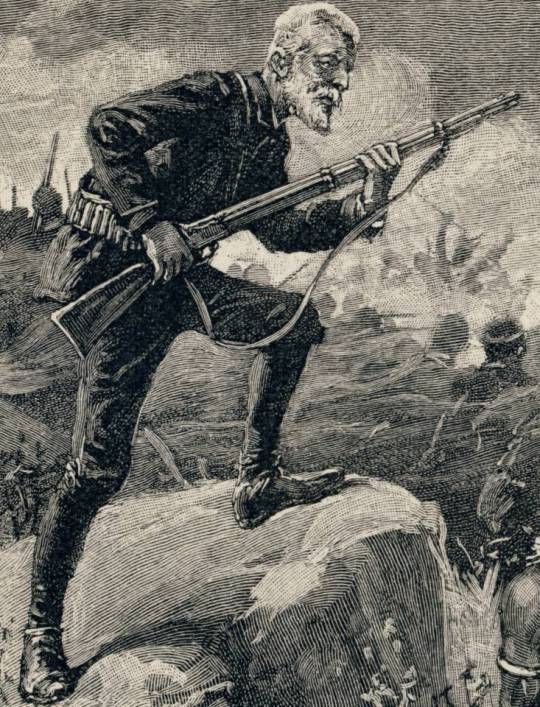
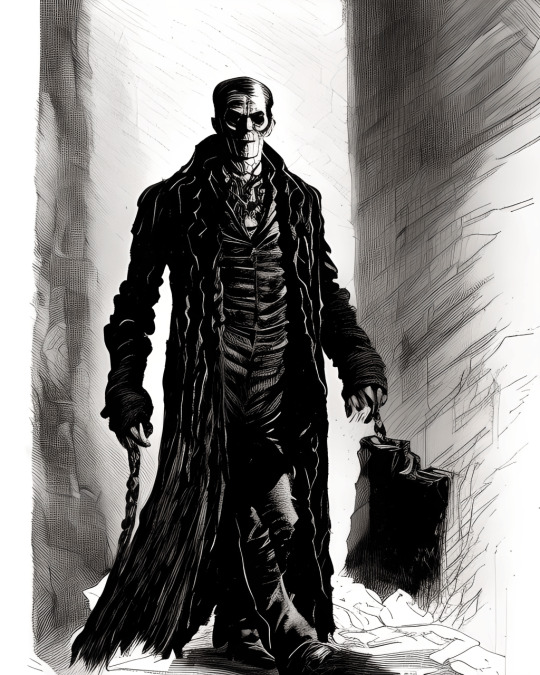

Allan Quatermain (Voiced By J. Michael Tatum)
FROM: The Novels Of H. Rider Haggard
Frankenstein's Monster (Voiced By Derek Mears)
FROM: The Novel Of Mary Shelley
The Mummy (Voiced By Oded Fehr)
FROM: Ancient Egyptian Mythology

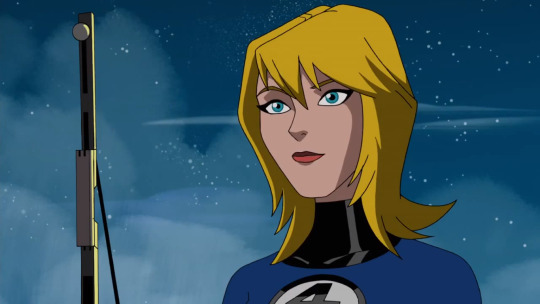
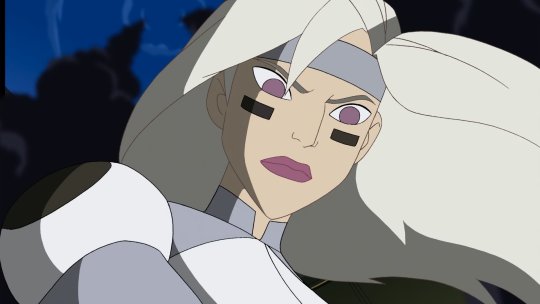
Mary Jane Watson (Voiced By Vanessa Marshall)
FROM: The Spectacular Spider-Man (2008 - 2009) with her early Ultimate Spider-Man (2012 - 2017) design
Susan "Sue" Storm aka Invisible Woman (Voiced By Erin Torpey)
FROM: The Avengers: Earth's Mightiest Heroes (2010 - 2012)
Sable Manfredi aka Silver Sable (Voiced By Nikki Cox)
FROM: The Spectacular Spider-Man (2008 - 2009)
What the hell is all this —
Heavily inspired by Alan Moore's comics, I want to create and make a potential video game or animated film or animated TV show called "The League Of Most Wanted" that brings together several characters of famous literature, mythology and even action cartoons of the 2000s and early 2010s.
3 notes
·
View notes
Text
Alan Moore is widely regarded as one of the greatest comic book writers of all time, and his contributions to the medium have been immense. From his groundbreaking work on characters like Swamp Thing, Batman, and Superman, to his groundbreaking graphic novels like Watchmen and V for Vendetta, Moore has had a huge impact on the world of comics. Here are ten of his most acclaimed graphic novels that every comic book fan should check out:
1. Watchmen by Alan Moore and Dave Gibbons: This is arguably Moore's most famous work and is considered a classic in the comic book industry. The story takes place in an alternate history where superheroes exist, and it explores the consequences of their actions and the psychological toll it takes on them.
2. V for Vendetta by Alan Moore and David Lloyd: This graphic novel is set in a dystopian future where a masked vigilante known as V fights against a fascist government. The story is a powerful commentary on fascism, totalitarianism, and the importance of individuality and freedom.
3. The League of Extraordinary Gentlemen by Alan Moore and Kevin O'Neill: This graphic novel is an epic adventure that brings together some of the greatest characters from Victorian-era literature, including Allan Quatermain, Captain Nemo, and the Invisible Man. The story is a thrilling blend of action, mystery, and history.
4. From Hell by Alan Moore and Eddie Campbell: This is a meticulous and haunting investigation of the Jack the Ripper murders, weaving a web of conspiracy and intrigue that stretches from the slums of Whitechapel to the highest levels of power in Victorian England.
5. Swamp Thing by Alan Moore and Steve Bissette: Moore's run on Swamp Thing is considered one of the greatest in the character's history. He transformed the character from a traditional monster comic into a sophisticated meditation on the nature of life, death, and the environment.
6. Promethea by Alan Moore and J.H. Williams III: This is a magical and mystical journey through the Imaginal realms of the mind and the soul, following the adventures of a young woman named Sophie Bangs who becomes the latest incarnation of the mythic warrior Promethea.
7. Batman: The Killing Joke by Alan Moore and Brian Bolland: This graphic novel is a dark and psychological examination of the relationship between Batman and the Joker, exploring the nature of their conflict and the madness that drives the Joker's actions.
8. The Miracles of God by Alan Moore and Mitch Jenkins: This is a series of short stories that explores the supernatural, the miraculous, and the mysterious, touching on themes of faith, wonder, and the unknown.
9. Neonomicon by Alan Moore and Jacen Burrows: This is a horror story that explores the limits of the human mind and the dangers of knowledge and obsession. The story is a continuation of the themes and characters first introduced in Moore's acclaimed series, The League of Extraordinary Gentlemen.
10. The Courtyard by Alan Moore and Jacen Burrows: This is a noir-style horror story that explores the horrors of addiction and the dark places to which it can lead. The story is a vivid and unsettling look at the dark side of human nature.
5 notes
·
View notes
Text
Different comic art styles and narratives
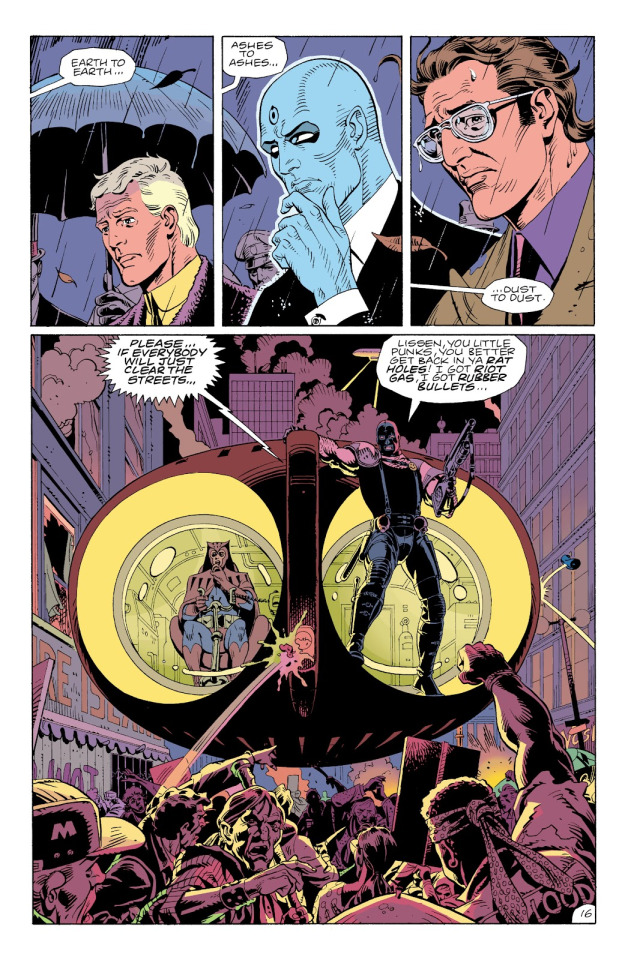
In an alternate 1985 America, costumed superheroes are part of everyday life. When one of his former comrades is murdered, masked vigilante Rorschach (Jackie Earle Haley) uncovers a plot to kill and discredit all past and present superheroes. As he reconnects with his retired associates, only one of which has true powers, Rorschach glimpses a far-reaching conspiracy involving their shared past and catastrophic consequences for the world's future.
Watchmen's story is very unique in the fact that it mixes superheroes with the real world, having links to specific parts in our history but being completely different because of the influence of super heroes. i don't think that my story and watchmen have much in common, i think the only thing in common with the stories is magic / powers.

all the super heroes at there base are humans, that is no the case for mu characters, none of my main characters are human, most have human features but none are actually born human, i did this for diversity but also i just prefer drawing fantasy creatures
the artist for the comic is called Allan Moore his art style is very appealing using a harsh black for the shadows as well as cross hatching instead of darkening the colours, however he does use darked colours for texturing. his art style is easy to spot his style due to his unique style of shading and colouring, using eye catching colours without them being too bold or vibrant, this fits in with the super hero vibe. Sin city

Sin City is a movie that tells four tales of crime adapted from Frank Miller's popular comics. The movie is heavily influenced by film-noir and features a muscular brute who's looking for the person responsible for the death of his beloved Goldie, a man fed up with Sin City's corrupt law enforcement who takes the law into his own hands after a horrible mistake, a cop who risks his life to protect a girl from a deformed pedophile, and a hitman looking to make a little cash
Sin City- I really like the detail in each of the character designs and the minimal use of colour, but this style of working would not work for me or my own comic as it would be too long a process. Having to draw each of these characters across multiple panels on one page would be far too difficult, and take too much time.
my story isn't as dark as sin city, although most of my characters have dark backstories, and some dark things happen to my characters, but my story doesn't really include rape or pedophiles, but it does include drug use, murder and death.
Scott Pilgrim vs The World: Scott pilgrim is very cartoony in style, and the shading uses a harsh black which I appreciate in practicality, but it's not the way I like to shade personally as I think it makes the characters look a bit too flat. The colour palette is also consistent throughout the page, with each panel sharing the same or very similar colours. I struggle with colours a lot, and find it difficult keeping them consistent through the page. To help me I usually use Pinterest, finding specific colour schemes to use on individual characters and environments.

I often don't use colour in my work and am currently unsure if I will colour my comic. I find it interesting that Scott Pilgrim was originally released in black and white, to resemble a manga:
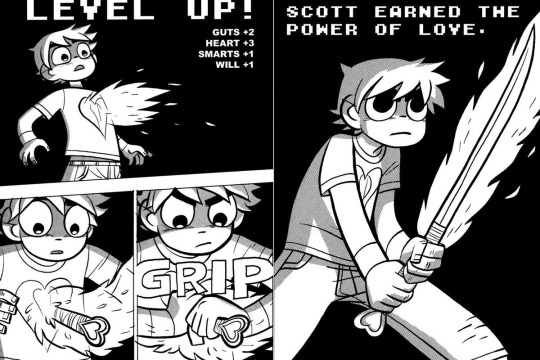
Sweet Tooth:
Gus, a young boy with deer-like features, lives a quiet life deep in the woods with his father. He learns many things, from medical care to religious prophecy. Though he loves his religious father, he yearns to escape as he learns that there is not fire past the trees but simply more land

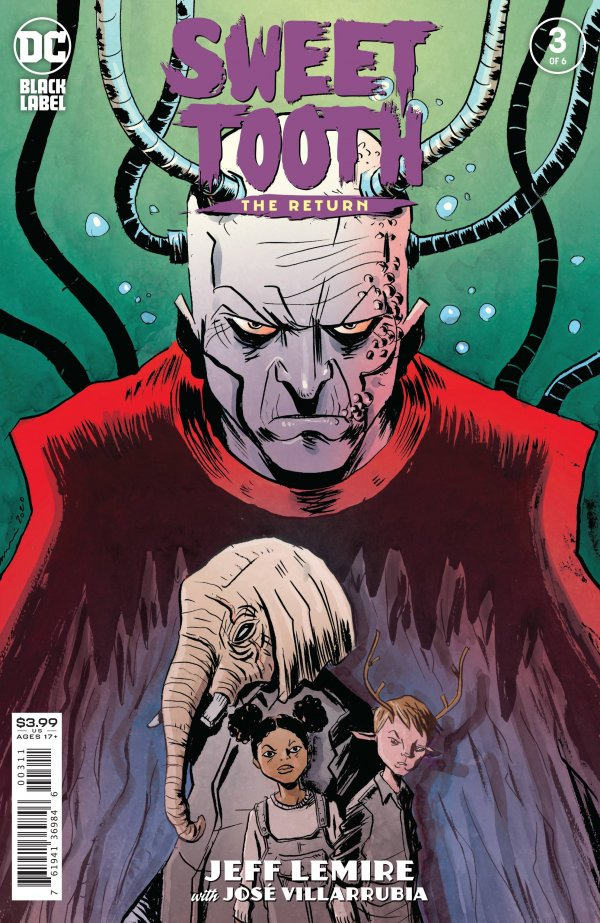
my mum and dad watched the Netflix adaptation for the comic and i watched a few bits of it as well, and know the plot has to do with the father hiding his son in the woods as well as some kind of virus. my story does not involve a virus it does involve something being hidden, i also have a half deer character like Gus, called Gregory although he is not a main character and just a baby, but he's still partly inspired.

i really enjoy this art style its angled and unique, i enjoy angled artwork as it can show movement and look neat while look appealing. i should probably try to draw in a simplistic style as it will be better for producing work faster, but i can always cut down on time in different ways, like in this comic using a lack of colour and bold black for dark shading. however some of the comic is in colour which i think is done really well keeping characters distinct from their backgrounds while also keeping a realistic look to the panels and the world.
0 notes
Text
As I've said before, the only difference with my Sandman stories and those Gaiman wrote are that I switch the protagonist:
I use Death as the protagonist instead of Dream, but it's the same cosmology and the overall history is much the same. Gaiman is on record as noting that the same events told from Desire's perspective would have Desire as the hero and Dream as the villain, though I still have problems connecting that with the things Desire actually does in these stories and how you'd turn that into heroism unless we're using the Allan Moore/Mark Millar definition of both actions and their ultimate outcomes.
Death of the Endless is not Dream of the Endless, Death of the Endless also canonically is beyond the ancient rules of the other Endless. This hasn't been specified in the show, as yet, but since so much else is the same with the comics except in a few cases I'm running with it for the sake of the Netflix shows and providing both good reasons for why she ultimately didn't intervene (including repeatedly going to Destiny to be sure if she did she wouldn't create a tremendous mess and Destiny doing his ambiguous 'did he shape events or did his words get taken as fate' thing) and ways where things could have gone wrong if she did because, surprise surprise, she's not a superhero or a trained fighter and going into a hostile situation against people able to hold one such being intact can boomerang badly on another.
She is also established as the most human (which I extend due to setting my stories in the broader DCU for my own reasons to being the most like all life in the DCU, and they would all see her as one of them if they did) of the Endless. As such the main motif that drives her is distinct from Dream, who is caught between various facets of duty, personal life, and the gaps between them.
Death is Life as well as Death and her great frustration is that being the most like mortals leaves her the odd one out among beings like her, with psychological and other barriers nearly insuperable to breach, and where she's also too inhuman to get along with human (insert equivalent turn of phrase for every other sapient species in the broader cosmology).
One careful rule that I follow with all of this is noting that Death is human-like, not human. She will seem human enough until something abruptly happens that serves as a note that no, she's not human, she never was.....and she's fully aware of that fact. Which is one reason for playing with all the different iterations of 'being stuck as one thing and almost that but never quite it gets the full version and handles it far better than the rest of her siblings but unfortunately the universe doesn't allow for this particular thing to stick' as a storyline.
It's also why other Endless appear in the ways they do.
Tales that would switch the protagonist to any of the other Endless would likewise be able to keep the setting fully intact, without changing anything else, and merely switching the kinds of stories it would be. Desire and Despair are the obvious ones, but a Delirium-centric set of stories as a kind of surrealistic Beatnik-style tale of a wandering eldritch entity who's an adorable sister who's a coherent (more or less) seer around her family and casually Wishmastering mortals for LULZ would be just as truthful a perspective flip.
With the youngest Endless in turn defined by being treated as a child when she isn't one and being the most dangerous of all the Endless to cross for being a multiversal reality-warper without any control of her powers or understanding of why turning a person into a glass statue for shits and giggles might be seen as wrong or disturbing.
Literally any and all of the other Endless work like this, I just like Death the most so I use her as the protagonist to explore both perspective flips and how flexible the cosmology and overall narratives of Sandman as a setting actually is.
#death of the endless#writing#death works very well as a protagonist and can and does have an uncanny valley aspect to things#she is human-like but she is not human#I use Lovecraft's Nyarlathotep as a model as Nyarly in the original mythos is a charming affable rogue#and then he casually wrecks Earth from constructive criticism over the equivalent of a powerpoint presentation#Death equally is very human and that includes humanity's flaws and downsides as well as the upsides#she can be petty and vindictive when she wants and has a hair trigger temper#unlike Dream she is somewhat casual about her job and unconcerned if it hitches#very much not Marvel's Death who hires Thanos as a contract killer from being unhappy with superheroes#Death is a good big sister to Dream and within limits to Delirium and past that her relationship with the rest of the family is iffy
1 note
·
View note
Text
Vampire Mina Harker fencing with swordmaster Dorian Gray, who is immortal?
Gunslinger Tom Sawyer mentored by the Greatest and Whitest Hunter Allan Quartermain?
Captain Nemo casually inventing the car because he needed a diversion from creating the most advanced submarine vessel ever unknown to western civilization at the time? With "call me Ishmael" as his first mate?
A poignant ending with an absolute beast of a call back and sequel hook?
This movie was horribly underrated and I the superior story compared to Allan Moore's comic.
Currently watching for the umpteenth time:

33 notes
·
View notes
Text
Movie Review | Death Smiles on a Murderer (D’Amato, 1973)

This is a ‘70s Italian horror film, meaning that the women are all absurdly beautiful and maybe a little perverted deep down, and the men carry a sense of imminent danger. This is also a period horror film, meaning that the characters are often costumed in pleasingly textured fabrics, and the women often wear extravagant headgear, and we get to spend a good amount of time in finely aged manors, their ornate designs coated with a nice coating of dust and wear. It even throws the lead actress in a cape and has her wander down creepy corridors, which is the ultimate sign of quality in films like this one, even if it contrives the scene by placing it after a costume party. (One should not need an actual reason to drift down the halls of a manor in a cape. As for that costume party, it has the characters playing a game where one of them guesses who is behind each mask, which is a much less impressive feat when you consider the masks barely cover their faces and their costumes are otherwise quite distinct.) What I’m saying is that the film contains a number of elements that make me already inclined to like it, but there are things that might make it engaging for those without the exact same cinematic tastes as myself.
The plot is...difficult to explain. There’s the opening scene where the main character is sexually assaulted by a hunchback, whom she also loves, but maybe gets involved with somebody else. And then many years later, either the same character or somebody who looks like her is in a carriage accident where the coachman is killed and she’s rendered unconscious and possibly stricken with a case amnesia. Enter Klaus Kinski as a doctor, whose tests involve turning around as she undresses while watching her with a comically large mirror and later poking a needle in her eye, and I think we’re all glad that medical science has come a long way since the early 1900s. Oh, and there might be a serum to reanimate the dead. Oh, and the lady of the house has an affair with her, but only after trying to drown her in a bathtub. Oh, and there’s a character who I can only describe as Italian Tom Skeritt. Oh, and there are multiple scenes where character run away in fear from a (possible) female zombie, which carry the same charge as the central conflict of Petey Wheatstraw, where our hero Rudy Ray Moore tries to weasel out of a deal to marry the devil’s daughter because she’s so damn ugly.
If this sounds incoherent, it certainly plays that way as you watch the movie, but not entirely in a bad way. There is some dispute as to who wrote how much of the screenplay, but the general sense I get is that there were changes along the way, from what was originally supposed to be more of a giallo to something with a bit more gothic horror flavour. There are certain elements inspired by Edgar Allan Poe (a character gets trapped behind a brick wall, a black cat), tossed into the strange psychosexual blender that produced this movie. This is directed by Joe D’Amato, whose style has always struck me as simultaneously restrained and blunt. The restraint tamps down the narrative incoherence, to the point that the proceedings register has half-remembered memories stewing in one’s subconscious, rather than something overtly dreamlike. The bluntness gives a charge to the scenes of violence, which involve a good deal of facial trauma (shotgun blast, razor slice, eye-gouging by feline).
If you’ve seen the poster, of a guy who looks like Kinski getting his face scratched up by an angry black cat, I can confirm that happens, just not to Kinski. Kinski spends most of the movie away from the other actors and instead fiddling with lab equipment, which seems suspiciously like a ploy to manage the notoriously volatile actor. You do not get any explosive outbursts here, but even in understated mode, Kinski’s very presence suggests that he might go off at any moment. And in the lead role, you get Ewa Aulin, who goes a long way in making this movie work. I have no idea if she’s a “good” actress in the traditional sense, but I do know that she pulls off what’s required for the role, in that she manages to be distressingly sexy while suggesting twisted psychological depths. Maybe the movie cheats to make me like her by putting her in a cape, but the heart wants what it wants.
7 notes
·
View notes
Text
i just want to talk about books i love
a list of my favourite childhood books. that is to say: books i read in my childhood, not necesarily children’s books. these are the books i read obsessively over and over until they were absolutely worn down and cracked. for ovbious reasons im not including harry potter into the mix
*journey to the center of the earth - jules verne
i think every amab who was interested in books and sci fi read jules verne at some point in their lives. this was one of his most outlandish premises but the dry naturalist way in which he descrives the wonders the characters encounter and the dangers of survival they come across (beautifully rendered by Édouard Riou) made me go back to it again and again.
*codex - lev grossman
turns out the guy who wrote the magicians did other things in his past as well. this book was fascinating to me because, out of all the books in this list, i think this is the one where no genre or supernatural elements occur. is about a banker who spends his first vacation in years unpacking and organizing the books of a private collection which leads him into an in depth quest to find one incredibly obscure middle age text that was lost to history. and yet lev manages to descrive all of this in such a wacky, whimsical tone than even descriptions of a guy playing a weird avant garde videogame are enthralling
*deception point - dan brown
i claimed time and again that dan brown is a sci fi writer trying to pretend he is a historical writer, this is the proof. this was the book he wrote before angels and demons, before he cemented himself with robert langdon forever. electoral drama, goberment conspiracies, cientific discoveries in the artic, weird near future sci fi tech, aaron sorkin level writing, dan brown second and last female protagonist, alien fossils trapped in meteorites. this book has everything
*amazing space - ann jeanette campbell
another thing related to space, the joke about how every kid when they reach age has to choose what they are going to bo obsessed with, dinosaurs - bugs - space. guess which one i choose. thanks to this book i passed most of my science tests with flying colors.
this is the one of three non fiction books in this list. one of those books that you dont really read sequentially but rather that you just jump all over the place, back and forth, finding weird little wonders wherever you go. this was the book that introduced me to the concept of dark matter, neutron stars, the cosmic background radiation, quasars. it showed me that reality is way weirder than i expected and that there are truly strange things out there.
*the sorcerer’s companion - allan & elizabeth kronzenk
i said i wouldnt mention harry potter but i can’t not mention this. my first earnest introduction to the world of actual historical magic and myth as it was practisced in the real world. it showed me how magic actually looked in the past, how it worked, what were the actual beliefs, myths and superstitions of people and how they were far more eccentric and peculiar and off kilter than anything rowling could come up with.
it was the book that made me unironically practisce numerology and astrology and reading tea leaves when i was a kid. it was also the perfect gateway drug to the kind of weird shit alan moore would preach at me when i was a teenager/young adult. fantastic history lesson packaged in an endearing way
*between nothing and eternity - roberto pettinato
pettinato is a stand up comic from argentina, one i am fond of. this book collects random thoughts, long digressions, short stories, stand up sets and other tangential observations that the guy made across his carrer. an incredibly eclectic book that has way too much fun playing around with typography. it replicated in an eerie way (even though at the time i couldnt possibly have known) the feeling of scrolling on tumblr and coming across the effort posts and deranged shitposts made by your mutuals. another eerie thing is how pettinato’s writing style is so incredibly good at conveying his own speech patterns, you cannot help but read this book in his voice, never before or after speech, cadence, delivery, timing, emphasis and tone was so perfectly conveyed in writing.
*the warm-up battle - marcelo figueras
i said more than enough about this book already. my favourite book of all time.
*the girl who loved tom gordon - stephen king
one of kings lesser known books, also the first book by stephen king i ever read. and much like the tip of the iceberg, much like the smallest tendril from the great eldritch beast that reaches from beyond time into my mind, i was amazed and astounded by it without even suspecting that there was so much more where that came from.
this was probably the first book i ever read with a female protagonist. whats more, a female protagonist of my age. again, as someone who was socialized as a boy, i was surprised at how relatable, how close, how immediate the conection to her was. she did things in her mind that i thought only i did. now the title may make you think this is some cute teen romance book or whatever. its actually and incredibly raw and terrifying story of survival, about a girl who got lost in the woods for days and days with nothing but her portable radio (that i would picture as the little pink walkman i had as a kid) and the prescence of something wrong, following her in the woods
*lessons in fear - diana shaw
and while on the subject of female protagonists, this is a practically completly unkown little teen novel where you follow a teenage girl who decides to become a private investigator and find out who has been pulling (potentially lethal) pranks on the most hated teacher at school. yet another book that surprised me by how much i related to the female protagonist as a kid, specially considering it was probably the only book i ever read where menstruation is not only brought up as a thing that exists but on top of that is brought up in a completly non chalante way as in yeah, whatever, it happens, its really annoying, ugh, i forgot my tampons, what a drag. which blew my 11 year old mind
the paris enigma - pablo de santis
speaking of murder mystery, this is The murder mystery novel. the one muder mystery novel that is all murder mystery novels that have ever existed. the ultimate tribute to the genre. it’s set in the late 1800′s, the eiffel tower is about to be completed for the world’s fair and the great twelve detectives, a world spanning organization composed by the best detectives of the world, are getting together. with them there are their adlateres, their assistants, their watsons. among the adlateres we follow one kid, the most recent addition to the group, someone who grew up reading detective stories his entire life and now had to prove himself as a worthy addition to the team. much like worm is the ultimate superhero story and worth the candle is the ultimate rpg isekai, this one is the ultimate crime novel
_______________________________________________________________
extra material
honorary mentions, books that i only read once as a kid and yet they still had a profound impact on my mind:
*the words - jean paul sartre.
the guy talks about his childhood, i had this idea that the guy was a dense and complex philosopher but his writing ended up being very enjoyable and relatable
*the invention of morel - adolfo bioy casares
the proof that latin america could create some amazing science fiction
*the eight - katherine neville
im honestly surprised not more people are talking about this one. dan brown done right. or more precisely the davinci code is katherine neville done wrong
*the metamorphosis - franz kafka
i was surprised at how straight forward the concept was explored, it almost felt like speculative fiction
*trafalgar - angelica gorodischer
the other proof that argentina could create some amazing science fiction, and make it but gustingly funny
*blindness - jose saramago
yet another example in this list of a writer that i expected to be dense and incomprehensible and dull and yet surprised me at how straightforwardly it explored a genuenly fascinating idea
*locked room - paul auster
and this is the one book that breaks that trend. i have no idea what the hell this book is about. i remember it was faintly disturbing to read. it was the book that started my obsession with thoroughly filing and archiving everything i create
#tbh i had to cut off so much stuff#i could go on for hours and hours talking about it all#god i couldnt even include nero corleone#or the almostdog of hunger#or the pillars of the earth#or artemis fowl#or everything borges ever wrote#etcetera etcetera etcetera#books#books!#BOOOOOOOKS!#writing
10 notes
·
View notes
Text
‘Love Boat,’ ‘Mary Tyler Moore’ star Gavin MacLeod dies at 90

By Associated Press
| May 29, 2021 at 2:44 PM CDT - Updated May 29 at 5:15 PM
LOS ANGELES (AP) — Gavin MacLeod, the veteran supporting actor who achieved fame as sardonic TV news writer Murray Slaughter on “The Mary Tyler Moore Show” and stardom playing cheerful Capt. Stubing on “The Love Boat,” has died. He was 90.
MacLeod died early Saturday at his home in Palm Desert, California, said Stephanie Steele Zalin, his stepdaughter. She attributed his death to his age, saying he had been well until very recently.
“He had one of the most amazing, fun blasts of a life of anybody I know. He enjoyed every minute of it,” Steele Zalin said. “I don’t even think in his wildest dreams he dreamt of the life that he ended up having and creating.”
She called him the “best, sweetest, purest guy.”
Ed Asner, who played opposite MacLeod on “The Mary Tyler Moore Show,” said on Twitter that “my heart is broken. Gavin was my brother, my partner in crime (and food) and my comic conspirator.”
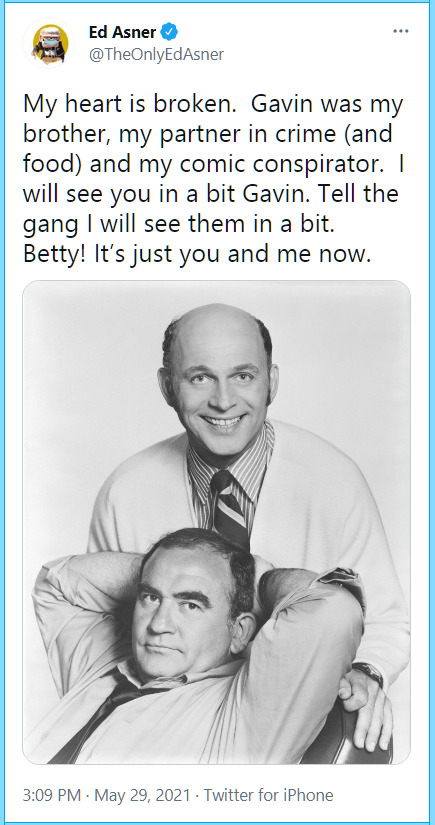
Known to sitcom fans for his bald head and wide smile, MacLeod toiled in near anonymity for more than a decade, appearing on dozens of TV shows and in several movies before landing the part of Murray in 1970.
He had originally tested for Moore’s TV boss, Lou Grant, the role that went to Asner. Realizing he wasn’t right for playing the blustery, short-tempered TV newsroom leader, MacLeod asked if he could try instead for the wisecracking TV news writer, his jokes often at the expense of the dimwitted anchorman Ted Baxter.
“The Mary Tyler Moore Show” was a smash from the start and remains a classic of situation comedies. It produced two spinoffs, “Rhoda” and “Phyllis,” starring Valerie Harper and Cloris Leachman, respectively, who had portrayed Mary’s neighbors.

It was still top-rated when Moore, who played news producer Mary Richards, decided to end it after seven seasons.
MacLeod moved on to “The Love Boat,” a romantic comedy in which guest stars, ranging from Gene Kelly to Janet Jackson, would come aboard for a cruise and fall in love with one another.
Although scorned by critics, the series proved immensely popular, lasting 11 seasons and spinning off several TV movies, including two in which MacLeod remained at the cruise ship’s helm. It also resulted in his being hired as a TV pitchman for Princess Cruise Lines.
“The critics hated it. They called it mindless TV, but we became goodwill ambassadors,” he told the Los Angeles Times in 2013.
Among his final TV credits were “Touched by An Angel,” “JAG” and “The King of Queens.”
MacLeod’s lighthearted screen persona was in contrast to his private life. In his 2013 memoir, “This Is Your Captain Speaking,” MacLeod acknowledged that he had struggled with alcoholism in the 1960s and 1970s. He also wrote that losing his hair at an early age made it hard for him to find work as an actor.
“I went all over town looking for an agent, but no one was interested in representing a young man with a bald head,” he wrote. “I knew what I needed to do. I needed to buy myself a hairpiece.” A toupee changed his luck “pretty quickly.” By middle age, he didn’t need the toupee.
In a 2013 interview with The Associated Press, MacLeod frequently invoked the word “grateful” as he reflected on his born-again Christian faith, surviving two heart attacks and his robust life.
“That’s a big word in my life. I’m just so grateful I’ve had another day, another day, another day, and that my kids are doing so well,” he said.
MacLeod, whose given name was Allan See, took his first name from a French movie and his last from a drama teacher at New York’s Ithaca College who had encouraged him to pursue an acting career.
After college, the native of Mount Kisco, New York, became a supporting player in “A Hatful of Rain” and other Broadway plays, and in such films as “I Want to Live!” and “Operation Petticoat.”
He made guest appearances on TV shows throughout the 1960s, including “Hogan’s Heroes,” “Hawaii Five-O” and “The Dick Van Dyke Show.” He also appeared on “McHale’s Navy” from 1962 to 1964 as seaman Joseph “Happy” Haines.
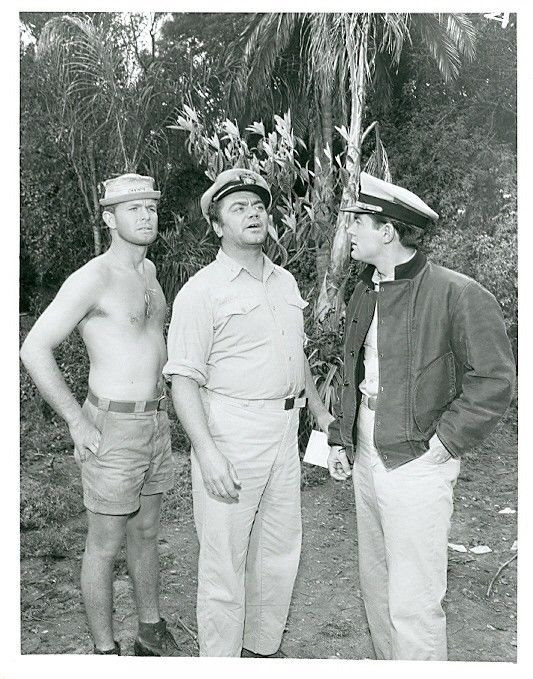
The reason MacLeod reluctantly signed up for the 42 weeks of guaranteed work on McHale’s Navy was because he was anxious about how he was going to make the payments on his new house in Granada Hills .
“I had like two lines a week … I started to feel sorry for myself, I started to drink and I became very, very unhappy,” he said in the TV Archive interview. “As an actor I felt I was going down the tubes.”
MacLeod said he put his foot on the brakes moments before driving his car off a cliff near Mulholland Drive.
He implored producer Eddie Montagne to let him off the show. “And then Robert Wise called me to do The Sand Pebbles in China with my old friend, Steve McQueen,” he said. “So my career started again, I had an identity, and I started to feel good about myself.”
One major role he auditioned for: Archie Bunker in “All in the Family.” But he quickly realized that the character, immortalized by Carol O’Conner, was wrong for him. “Immediately I thought, ‘This is not the script for me. The character is too much of a bigot.’ I can’t say these things,” MacLeod wrote in his memoir.
Other movie credits included “Kelly’s Heroes,” “The Sand Pebbles” and “The Sword of Ali Baba.”
MacLeod had four children with his first wife, Joan Rootvik, whom he divorced in 1972. He was the son of an alcoholic, and his drinking problems helped lead to a second divorce, to actor-dancer Patti Steele. After MacLeod quit drinking, he and Steele remarried in 1985.
Raised Catholic, he credited Steele for their shared born-again faith. The couple hosted a Christian radio show called “Back on Course: A Ministry for Marriages.”
Besides his wife, MacLeod’s survivors include his children, three stepchildren, 10 grandchildren and his first great-grandchild, who arrived in December, Steele Zalin said.
___
The late AP Entertainment Writer Bob Thomas contributed biographical material to this story.
Copyright 2021 Associated Press. All rights reserved.

Enjoy! ↓
💙 https://www.metv.com/videos/metv-originals/MeTV-Presents-The-Best-of-Gavin-MacLeod 💙
16 notes
·
View notes
Text
like this is an LXG AU made by people who believe, or believed, that:
-Allan Quatermain was an original Moore character (he isn't; he's from a series of books that have gone out of fashion so i cant really blame them but... come on)
-Mina was only in the comics to have sex with Hyde to "tame him" (SHE'S LITERALLY THE PROTAGONIST, LEADER OF THE LEAGUE, AND CENTERPIECE OF MOST LXG COMICS... THE LEAGUE LOGO IS HER FACE)
-The Griffin in the comics is a different, new Griffin, in part because they think he's OOC (he's not)
-Alan Moore messed up Dorian's writing in the comics (Dorian isn't in the comics) (he's in the movie) (you know, the movie Moore hates and had nothing to do with)
-Moore drew for all his comics (he doesnt. he cant draw.)
-Moore is an imperialist (??? he's a communist what are you talking about. the comics are satire- clumsily done satire but satire none the less!)
Like
at least fucking read the wiki to understand what is there to criticize, which is a lot, but at least it wont be made up... you cant just jump to make an AU based on SPITING a comic if all the things you spite about it don't even exist!
the more i learn about the league of extraoridnary gentlefolk comic project thing i see the more it sucks. honestly.
this is an LXG au written by people who havent read the comics and dont even know half of whats going on in them
like. if your LXG au has Jonathan as the overpowered centerpiece, all of the Dracula cast as members of the League, along with a Hyde that doesn't kill, and a character from a piece of racist propaganda, um. that's not LXG
its like making a Justice League AU without Batman and with Iron Man. idk.
also one of the writers is the guy that wrote That Awful Fic in which Hyde is depicted as. all the ableist caricatures he can be depicted as at once. so.
21 notes
·
View notes
Text
Directed by: Matt Peters, Christina Sotta
Written by: Ernie Altbacker, Mairghread Scott
Starring: Matt Ryan, Taissa Farmiga, Tony Todd, Stuart Allan, Jerry O’Connell, Jason O’Mara, Rosario Dawson, Rainn Wilson, Christopher Gorham, Shemar Moore, Hynden Walch, Roger Cross
Reviewed by: Eric Joseph
Summary
Although DC animated movies are certainly nothing new, we’ve recently been witness to a particularly special era influenced directly by New 52 comics since Justice League: War debuted in 2014 (2013, if you were to count Justice League: The Flashpoint Paradox). In addition to DC’s premier superhero team enjoying their own group outings, we’ve also been treated to loose adaptations of classics such as Batman: Hush, Teen Titans: The Judas Contract and The Death of Superman.
But, as they say, all good things must come to an end.
And that’s where Justice League Dark: Apokolips War comes in. Initially assumed to be an adaptation of Darkseid War, it’s nothing of the sort. Some influence from Futures End seems to be in there, but I’d describe this as being an original story for the most part. For all intents and purposes, this is the Avengers: Endgame of the New 52-inspired DC Animated Universe. However, there’s one major difference: Apokolips War isn’t getting a sequel or continuation. This is it.
(Don’t worry. More DC animated films are on the way, with Superman: Man of Tomorrow releasing this summer. To be clear, nothing released beyond this point will tie in to the New 52 stuff. My hypothesis is that the focus will be shifted to standalone graphic novel adaptations and original stories.)
Positives
Much like the aforementioned Endgame – and unlike Infinity War – Apokolips War isn’t an overcrowded affair, even though it features guest appearances by various members of the Justice League, Justice League Dark, Suicide Squad, Teen Titans and Bat-family. For the most part, the narrative is pared down to following John Constantine, Clark Kent, Raven, Etrigan and Damian Wayne as they try to salvage what’s left after Darkseid has devastated the Earth.
To backtrack for a moment, the movie starts off with the Justice League’s heaviest of hitters taking the fight to Apokolips, but then everything goes horribly awry. Yes, this could be categorized as somewhat of a spoiler, although anyone who’s watched the first look featurette or kept up with news pertaining to the flick already knows this to be one of the basics. After that, there’s a two-year time jump that brings us to the ragtag group coming together.
If anything, I have to applaud the filmmakers for taking some serious risks. I can’t believe they got away with a lot of the stuff on display, and I’m not exactly talking about the R-rating and subsequent F-bombs. Instead, expect to see some gargantuan swings taken, with notable heroes you love dying in terribly gruesome ways. In fact, one fan favorite from the Bat-family gets eaten alive by a swarm of “Paradooms” (Parademon/Doomsday hybrids).
This slideshow requires JavaScript.
This may be too much for some to digest (pun intended), but those who’ve wanted to see what it’s like when superheroes who seemingly have nothing left to lose make one last effort to overcome the ultimate evil in a post-apocalyptic world will dig what’s on hand. Also, expect for some other heroes to be, um, repurposed and serving Darkseid.
Overall, I found the plot to be quite engaging and never thought the action to be overdone or extensive. The latter notion was found all too often in some previous flicks, what with Justice League: War feeling like one endless action scene. But here, characters actually get a chance to breathe and I was at attention the entire time, knowing this was the end of the journey.
Negatives
Actually, I don’t have much to say on the negative side this time around. Although I’m admittedly not fond of seeing superheroes get massacred, the death toll worked in this context. Still, this aspect could potentially shock some viewers who may have gone in looking for the happiest of endings. So far, I think most took it in stride, as I’ve seen some very enthusiastic online reaction that I wasn’t able to avoid. (I try going in without outside influence as much as humanly possible.)
One other thing I’d like to mention in the vaguest way – because I’m trying to spare major spoilers – is what occurs at the very end. I wouldn’t exactly call it a “Deus ex Machina” in the purest sense, but you may find yourself asking “why didn’t they do that thirty minutes ago?” Regardless, it makes for a beautifully bittersweet conclusion to this saga.
Verdict
Now, I’m not going to say Justice League Dark: Apokolips War is the best animated DC movie ever made like some are, but it’s pretty damn good nonetheless. If you’ve come this far, you have no fathomable reason not to check it out. Here’s hoping the folks in the animation wing keep it up with whatever comes next.
Review: Justice League Dark: Apokolips War Directed by: Matt Peters, Christina Sotta Written by: Ernie Altbacker, Mairghread Scott Starring: Matt Ryan, Taissa Farmiga, Tony Todd, Stuart Allan, Jerry O'Connell, Jason O'Mara, Rosario Dawson, Rainn Wilson, Christopher Gorham, Shemar Moore, Hynden Walch, Roger Cross…
3 notes
·
View notes
Photo

My girlfriend asked me to make her a list of works of fantasy and science fiction so should could feel keyed into references when they come up in conversation. She wanted to feel more grounded in these genres, which she likes, but hasnt made the effort to be on top of everything.
I was happy to compile the most important names, but told her it couldn’t be a short list because recognizing the works of today means honoring their origins, which goes way back into our past.
What’s below is my best effort to include what I assess to be the most culturally relevant becoming, tempering my favorites, and trying to keep it from being totally overwhelming. I’ve left off works from the past five to ten years because it can take a span of time before we're aware the effects new ideas may have. Felt like sharing here in case you or your friends want a crash course on the bedrock of our imagined landscape. I do try to be globally aware, however this list will reflect my bias as a white, straight, male who grew up in the States. And as this is an ongoing conversation between her and myself, I wanted to be able to vouch for the contents.
-Key-
(Wiki) Read up for cultural significance * Personal Favorite + Hugely influential ^ Non-Essential but worth listing
-Literature-
8,000 BC Aboriginal mythology (pre written language)
2,300 BC Egyptian & Chinese myths+
1,000 BC The Old Testament+
900 BC Greek myths, fables, and all the rest
300 BC - 1800 AD Folk and fairy tales+
1000 AD Beowulf (Wiki)
1100s Legend of King Arthur+ 1200s Norse mythology+
1300s The Inferno - Dante Alighieri+
1500s A Midsummer Night’s Dream - Shakespeare
1600s Paradise Lost*
1700s Gulliver’s Travels The Arabian Nights (Wiki)
1800s Faust Frankenstein* - Mary Wollstonecraft Shelly+ Grimm’s fairy tales+ (Wiki brothers, who collected folktales) The Strange Case of Dr Jekyll and Mr Hyde* Dracula - Bram Stoker+ Alice in Wonderland - Lewis Carroll+ Flatland The Time Machine & War of the Worlds - HG Wells+ (godfather of SF) Twenty Thousand Leagues Under the Sea - Jules Verne+ The Tell-Tale Heart - Edgar Allan Poe+
1900s Peter Pan - JM Barry The Comet - WEB Dubois Little Nemo in Slumberland - Winsor McCay The Book of Wonder - Lord Dunsany (less known now, he was highly influential in his time for fantasy & mythos) The Metamorphosis - Franz Kafka+ (Einstein’s Theory of Relativity) The Wizard of Oz - L. Frank Baum+ John Carter of Mars - (Wiki) Call of Cthulhu or The Outsider - HP Lovecraft+ Brave New World - Aldous Huxley (Teacher of Orwell https://bit.ly/2xayA23) 1984 - George Orwell+ Amazing Stories magazine - John Campbell+ (writer & editor)
After 1950 Lord of the Rings - JRR Tolkien+ Chronicles of Narnia* - CS Lewis I Am Legend - Richard Matheson (The first real zombie story. Also wrote for Twilight Zone) Childhood’s End - Arthur C Clarke+ I, Robot - Isaac Asimov+ Farenheit 451 - Ray Bradbury Funes the Memorious or The Garden of Forking Paths - Borges+ Slaughterhouse Five - Kurt Vonnegut Wizard of Earthsea or The Lathe of Heaven - Ursula LeGuin Stranger in a Strange Land - Robert Heinlein Dune Where the Wild Things Are - Maurice Sendak The Neverending Story* ^The Man in the High Castle Do Androids Dream of Electric Sheep? - (inspired Bladerunner) Philip K Dick+ The Hitchhiker’s Guide to the Galaxy A Wrinkle in Time The Stand - Stephen King+
After 1980 Invisible Cities - Italo Calvino Xanth series* Communion - (True account of alien abduction) Neuromancer - William Gibson+ Handmaid’s Tale - Margaret Atwood Jurassic Park - Michael Crichton+ Snow Crash - Neal Stephenson Ender’s Game* - Orson Scott Card Parable of the Sower - Octavia Butler A Song of Ice & Fire - George RR Martin ^Hunger Games Harry Potter - JK Rowling+ Who Fears Death
-Comics/Superheroes-
-DC Comics- Superman (Wiki how he came to be) Wonder Woman (Wiki how she came to be or watch Professor Marston and the Wonder Women. Very interesting) Batman (and Joker) The Sandman - Neil Gaiman Watchmen* - Alan Moore+
-Marvel Comics- Spiderman* (Wiki how he came to be) X Men* Avengers (the hugely popular films all started with decades of comics) Teenage Mutant Ninja Turtles* Hellboy*
-Games- Dungeons & Dragons+ Magic the Gathering Netrunner
-Artists & Illustrators-
1100-1200 Anonymous monk’s illuminated manuscript creatures - https://bit.ly/2Ynytf7
1400s Hieronomous Bosch+ Leonardo DaVinci Michelangelo+ 1500s Arcimboldo
1800s Gustav Doré+ Howard Pyle JW Waterhouse
1900s Maxfield Parish NC Wyeth+ Sir John Tenniel Windsor McCay+ Arthur Rackham - fairy tales Jack Kirby - superhero comics Margaret Brundage - Weird Tales covers Picasso - Cubism Chesley Bonestell - space travel, integral to NASA Frank Frazetta MC Escher Heinrich Kley Sun Ra - Afrofuturist musician
After 1980 Jeff Easley - D&D Jim Lee - X Men Michael Whelan H.R. Giger - Alien films Brian Froud Syd Mead - design of Bladerunner & other films Roger Dean - album covers Jean Giraud aka Moebius Bill Waterson - Calvin & Hobbes Leo Dillon and Diane Dillon James Gurney - Dinotopia Alan Lee - Lord of the Rings Alex Ross - superheroes Chris Van Allsburg Mike Mignola - Hellboy Mary GrandPré - Harry Potter
-Radio-
1930s -1950s Flash Gordon War of the Worlds (Wiki Orson Welles’ radio hoax) Buck Rogers The Shadow and much more in the ensuing years, including adaptations of The Lord of the Rings, Star Wars, and The Hitchhiker’s Guide
-TV Shows-
After 1950s Twilight Zone - Rod Serling Lost in Space Star Trek - (Wiki) Gene Roddenberry Dr Who (Wiki) The Jetsons (Wiki) Cosmos - Carl Sagan+ (Science fact)
After 1980s Transformers Quantum Leap Twin Peaks - David Lynch (not really either genre but impact has been undeniable) Buffy the Vampire Slayer* - Joss Whedon X Files* Neon Genesis Evangelion
After 2000 Firefly - Joss Whedon Lost* - JJ Abrams Battlestar Galactica Black Mirror* Game of Thrones Westworld* - reboot of Michael Crichton 1970s film
-Films-
1900s King Kong (Wiki) The Wizard of Oz+ Fantasia- Disney+ Monster movies- Dracula, The Mummy, The Wolfman, Creature from the Black Lagoon, Frankenstein (Wiki)
After 1950 Godzilla+ (Wiki) Seven Samurai or Hidden Fortress - Akira Kurosawa+ (Not SF or fantasy but influential) The 7th Voyage of Sinbad - Special effects by Ray Harryhausen (Wiki) Invasion of the Body Snatchers 2001 A Space Odyssey - Stanley Kubrick+ (Wiki) Planet of the Apes Night of the Living Dead+ (Wiki) Superman #Star Wars Trilogy - George Lucas (owing to Joseph Campbell’s monomyth)+
After 1980 Bladerunner* - Ridley Scott ^Legend Mad Max series Alien or sequel Aliens Close Encounters of the 3rd Kind - Steven Spielberg+ ET Star Trek series Back to the Future Brazil - Terry Gilliam+ Tron+ Ghostbusters* Bill & Ted’s Excellent Adventure* The Princess Bride* Labyrinth* The Terminator & Terminator 2* - James Cameron+ Akira The Fifth Element Robocop Beetlejuice ^Nightmare Before Xmas* Jurassic Park - Steven Spielberg+ The City of Lost Children* The Iron Giant* 12 Monkeys Groundhog Day* The Sixth Sense Ghost in the Shell (1995 anime) Gattaca* Donnie Darko* Starship Troopers (tongue in cheek adaptation of Heinlein’s classic) The Matrix*
After 2000 Crouching Tiger Hidden Dragon My Neighbor Totoro or Spirited Away - Hayao Miyazaki ^Underworld Minority Report Lord of the Rings Primer ^The Incredibles Shaun of the Dead* Pan’s Labyrinth - Guillermo del Toro Moon* Marvel Cinematic Universe ^Idiocracy Inception* &/or Interseller - Christopher Nolan+
#scifi#fantasy#essential#list#stories#collection#visionary#narratives#homework#crashcourse#genre#bestof
29 notes
·
View notes
Text
The Contention of Voice: Alan Moore’s Reshaping of Mr. Hyde’s Monstrosity ••• By Lissa Heineman
Having now completed The League of Extraordinary Gentleman’s fourth volume, it is possible comic culture’s favorite uncle, Alan Moore, is officially retiring from comics. The graphic novel series is celebrated for its gallery of famous characters from literary history, acting as a new-age compendium for Industrial Revolution-centric anachronisms. It’s both a Lit Degree-er’s nightmare and playground, remixing themes and characteristics from different classic works together. One such example is Moore’s take on the OG, 1800′s Hulk, Dr. Jekyll/Mr. Hyde.
Robert Louis Stevenson’s The Strange Case of Dr. Jekyll and Mr. Hyde was published in 1886, a time in which the debate around science and religion was intense. Charles Darwin’s The Origin of Species had been released in 1859 and made the Victorians begin to question their ‘infallible’ faith in God’s unlimited control, but also be wary of metaphysical sciences — a phenomena that studies the fundamental nature of reality. The book used its main characters to generate discourse about morality, reasoning, science, and faith, while reflecting upon the growing uncertainties that came with fin-de-siecle, or end-of-the-century, culture. To the modern reader, the basic message of Stevenson’s novel is clear: Hyde wasn’t simply a monster, and consequence of metaphysical practices, but a manifestation of Dr. Jekyll’s repressed self. However, this leaves a question of how human Hyde is in comparison to Dr. Jekyll, if they are one in the same. What is Mr. Hyde’s personhood? It is through the introduction of Alan Moore’s take on the character(s), that Mr. Hyde’s own character takes shape. By integrating characteristics of Edgar Allan Poe’s The Murder in the Rue Morgue into Hyde’s storyline, Moore argues for Hyde’s personhood and agency, not allowing him to simply be a figure of the Victorian’s metaphysical anxieties.
In Dr. Jekyll and Mr. Hyde, Jekyll is described as having become “too fanciful… [and going] wrong in mind,” practicing “unscientific balderdash” (Stevenson 12). Jekyll is framed as immoral, particularly in comparison to the book’s protagonists. His ‘science’ is described as “transcendental medicine” (Stevenson 52), ie: metaphysical inquiries. Jekyll’s research, and his addiction to his own chemicals, code him as a heretic. Stevenson indicates that Jekyll, himself, is problematic. Yes, Hyde is young and brutish with more physical capabilities than the older, deteriorating Dr. Jekyll, but he certainly isn’t the degenerative juggernaut illustrated in The League of Extraordinary Gentlemen. Rather, Mr. Hyde is described as “troglodytic” (Stevenson 16), “ape-like” (Stevenson 20), and “a monkey” (Stevenson 39). These descriptions of Mr. Hyde allude to the backwards progression of man’s evolution, as chronicled by Charles Darwin and the likes of Thomas Henry Huxley, reaffirming Jekyll as representative of a bastardization of London’s moral ideals of the time.
The League of Extraordinary Gentlemen clearly takes some creative liberties with its depiction of Mr. Hyde. In Issue 1, Hyde is seen easily holding Quatermain feet above the ground, close to the ceiling, easily in one hand, fangs barred and tendons and veins practically bursting across his collar and face. Across the same two-page spread, Auguste Dupin attempts to defend himself and Mina Murray from Hyde, shooting the monster in the face. Part of Hyde’s ear is blown off, which only increases Hyde’s anger, emphasized by the all-capitalized dialogue bubbles. Not only does Hyde retain the apishness described in Stevenson’s novel, but it is intensified, as seen via the fangs, flared nostrils, incredible muscle definition, and the overall brownishness of his complexion. He towers over all the other characters dramatically, alluding more to King Kong than how earlier adaptations had illustrated the character, which often emphasized “neanderthal” over “monkey”. Hyde was popularly depicted as an unkempt, twisted, and hunching man across films and drawings. There can be many reasons for this deviation within the comic’s universe, but one of the most obvious links is in how this Hyde is adapted not only from Stevenson’s work, but also Edgar Allan Poe’s The Murders in the Rue Morgue. The murders attributed to Hyde by Dupin in The League are ones that were committed by the Ourang-Outang in Poe’s short story. Even the way that Hyde’s anger increases when Dupin shoots him mirrors how the Ourang-Outang becomes agitated enough to murder the two women, which occured only when one of the women provoked it by screaming (Poe 35). Moore masterfully blends together Hyde and the Ourang-Outang to display the animalistic qualities of the former character.
However, what is most interesting regarding Hyde in The League is his communication -- his literal ability to speak. Never at a single point in Dr. Jekyll and Mr. Hyde does Mr. Hyde speak; we only hear Dr. Jekyll himself talk. A large part of Poe’s Rue Morgue mystery is based in “voices in... contention” (first on Poe 11). Witnesses heard the then-mysterious “arguing” of the deep-voiced French sailor and the shrill shrieking of the Ourang-Outang, and found the ape’s voice to be unidentifiable in gender and nationality. Dupin notes that:
"the voices of madmen, even in their wildest paroxysms, are never found to tally with that peculiar voice heard upon the stairs. Madmen are of some nation, and their language, however incoherent in its words, has always the coherence of syllabification” (Poe 28-29).
Poe introduces the idea that language is a characteristic of a nation, and therefore language being linked to personhood. It is this argument that leads to Dupin’s logical deduction that the murderer couldn’t have been human at all, as he didn’t have language or nation, and it is this language that brings us to question the boundaries between both Stevenson and Moore’s version of Jekyll, Hyde, and their divide.
Stevenson’s Mr. Hyde is a ‘mask’ for Dr. Jekyll; we never engage in Mr. Hyde’s perspective, and while Dr. Jekyll uses the potion to maintain control over both himself and his alternate-persona, we are never given evidence that Hyde himself has his own perspective. Hyde’s activities across the novel are described as bouts of rage that mirror the kind of blind activity that the Ourang-Outang perform: they are mindless performances of heated passion and emotion. On the other hand, Dr. Jekyll’s role is indisputable. In his confession of the murders in Stevenson’s novel he admits that he “mauled the unresisting body” (Stevenson 60), rather than referring to himself as Mr. Hyde, which would relieve himself of blame or control. This reaffirms Hyde as a costume for Jekyll’s depravities. Even in the final chapter, “Henry Jekyll’s Full Statement of the Case”, where Dr. Hyde’s body is “in control”, the character still refers to himself exclusively as Dr. Jekyll. Dr. Hyde is never autonomous, and he is never a singular being. These facts create a gap in how to read Mr. Hyde at all, because despite his own embodiment, he is very much just Dr. Jekyll.
Despite performing similar brutalities to Poe’s monster, Hyde/Jekyll is very human. However, when he’s offered a voice by Moore, Hyde becomes separate. Jekyll isn’t speaking through Hyde, and Moore’s Hyde becomes a near-replica of the dynamics that Marvel’s Bruce Banner and the Hulk engage with, as well as that of Poe’s Ourang-Outang and the Frenchman, who feared being accused as guilty for the crimes of the ape. Such dynamics are further displayed by Moore in Champion Bond’s explanation of Jekyll/Hyde. He describes Dr. Jekyll as “a highly moral individual” who “become(s) Hyde” whenever he is stressed (Moore Vol. 1). Moore and Stevenson’s characters here are distinctly separated. Moore’s choice to depict Hyde and Jekyll as split shifts the blame of Jekyll/Hyde’s actions away from Stevenson’s intended perpetrator: Jekyll, and onto Hyde, transforming Jekyll into a victim. Jekyll even offers a warning to the League as they approach the Limehouse District. With sweat beading across his forehead he admits “sometimes I’m not myself. I’m not sure I can always be relied on.” Stevenson’s writing posed a message that playing with science can drive a man mad and immoral. With Moore’s Hyde having his own distinctive personhood, Stevenson’s message is removed from the Jekyll/Hyde mythos.
Alan Moore offers an alternative take on Dr. Jekyll and Mr. Hyde. Departing from Stevenson’s classic allegory for the anxieties of scientific advancement, Moore uses the classic Poe story to explore Hyde as a separate force. Monstrosity, in the 19th century, was linked to the degradation of character and religion. However, Moore’s transferral of power over to Mr. Hyde, as suggested by both literal narration and the gift of speech, allows Hyde to take up the true mantle as a monster. Moore points to how this form of remix encourages reshaping perceptions of the familiar. This variation on Jekyll/Hyde can easily parallel the Ourang-Outang and the Frenchmen, Bruce Banner and the Hulk, and even deviating examples of both Frankenstein and his monster and The Fly’s Seth Brundle and Brundlefly, who both exemplify monsters with their own senses of personhood and creators who fall victim to their creations. One can see that Moore’s recharacterization of Hyde makes a classic work feel more approachable and non-other.
__
Works Cited:
Moore, Alan and Kevin O’Neill. The League of Extraordinary Gentlemen: Volume One. California: America’s Best Comics, 2000. Print.
Poe, Edgar Allan. The Murder in Rue Morgue. Feedbooks, 1841. Online. http://www.feedbooks.com/book/795/the-murders-in-the-rue-morgue
Stevenson, Robert Louis., and Roger Luckhurst. Strange Case of Dr Jekyll and Mr Hyde, and Other Tales (Oxford world's classics). N.p.: Oxford U Press, 2006. Print.
#lissa heineman#graphicnovel#alan moore#books#the league of extraordinary gentlemen#dr jekyll and mr hyde#literature#comics#adaptation#remix
4 notes
·
View notes
Text
Let's make a list of all J&H adabtations we know! Add everything that is still missing from this list
I've noticed during my years of being a J&H nerd that when you enter the J&H fandom, there is so many versions that it might be hard to keep track of all of them. Let's make a favor for new (and maybe old) J&H fans out there and list all the adabtations that featsure J&H at least in some level we know exist!
That way it's (hopefully) easier for new fans to get into J&H and old fans to check out addabtations they haven't yet seen.
I'm going to list both bad and good versions for in some cases it might be just opinion mather wheter or not they are terrible (though there are most likely some addabtations that most of the fandom can agree to be terrible but you get the point.)
Here's some adabtations I'm most familiar with:
The strange case of Dr. Jekyll and Mr. Hyde (the original book by R. L. Stevenson)
Dr. Jekyll and Mr. Hyde (movie, 1931)
Jekyll & Hyde; the musical
Dr. Jekyll and Mr. Hyde (movie, 2002)
The Search for Henry Jekyll ( webcomic by Midorilied)
The glass scientist (webcomic by Sabrina Cotugno)
Jackson Jekyll and Holt Hyde (Monster High versions of the characters)
Jekyll and Hyde (ITV tv-series, 2015)
Mary Reily (Book by Valerie Martin, there's also a movie based on the book)
The league of Extraordinary gentlemen ( Comic series by Allan Moore and Kevin O'Neil. Has Jekyll and Hyde as part of the main cast. There's also a movie based on the comic)
Dr. Jekyll and Mr. Hyde (animated cartoon movie, 1986)
Cap'n O.G. Readmore meet's dr. Jekyll and mr. Hyde (animated short from ABC weekend special, 1986)
Dr. Jekyll and Mr. Hyde: the manga (japanese comic, completed, one volume and 7 chapters, english translation (not sure if official or fan) avaible)
Once Upon a Time ( tv-series, not about J&H but Jekyll and Hyde are featsured as one "story arc" and interact with the main cast from season 5, ep. 22 (Only you) to season 6 ep. 04. (The strange case) after this they are not included in the series)
Please, add more if you know any!
59 notes
·
View notes
Photo

For the week of 26 November 2018
Quick Bits:
Action Comics #1005 gives us a reappearance of The Question and a HERO Dial--possibly counterfeit, possibly just doesn’t work for villains--amidst an advancement of the underground mob arc, a surprising “conclusion” to the arson case, and a revelation of who the Red Cloud is. Although there are many spinning plates, and a decided lack of conclusion to most of the arcs, I actually quite like how Brian Michael Bendis is crafting this story. You could argue that it’s decompressed, but it feels a bit like old school superhero soap opera, and that feel really works for Superman. It’s also aided immensely by the gorgeous artwork from Ryan Sook and Brad Anderson.
| Published by DC Comics
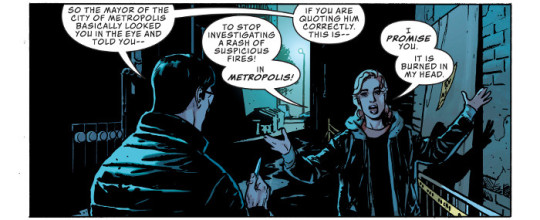
Amazing Spider-Man #10 concludes the “Heist” arc in a fairly impressive manner. Nick Spencer really seems to get Spider-Man, Mary Jane, and their world and is delivering some great character moments here, with great heart and humour. Humberto Ramos, Victor Olazaba, Edgar Delgado, Michele Bandini, and Erick Arciniega also do a wonderful job with the art.
| Published by Marvel
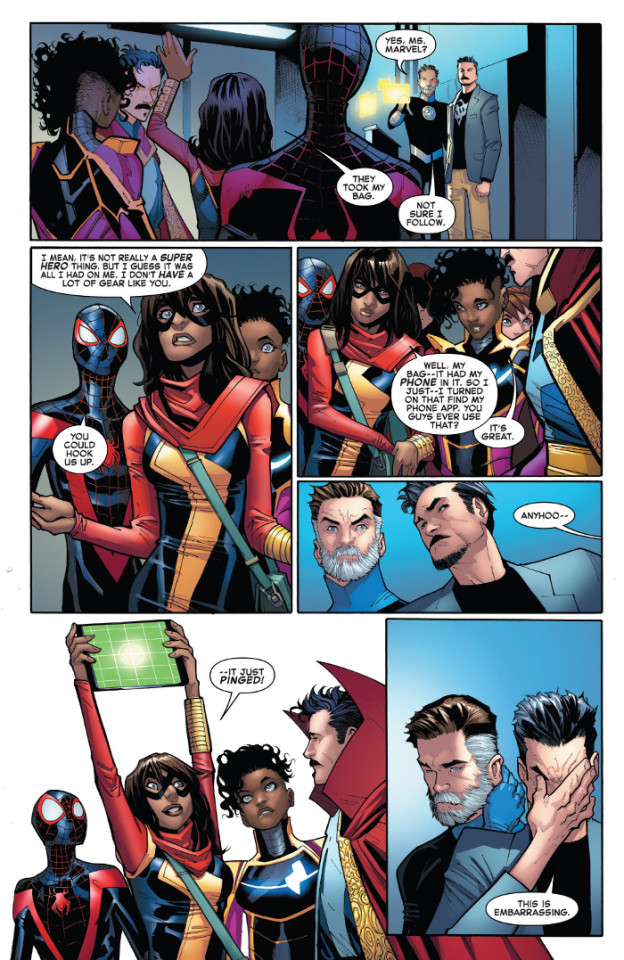
Aquaman/Justice League: Drowned Earth #1 concludes the “Drowned Earth” event in fairly epic fashion from Scott Snyder, Francis Manapul, Howard Porter, Scott Godlewski, Hi-Fi, and Tom Napolitano. While this even is definitely a vehicle to move Aquaman to his new status quo for incoming Kelly Sue DeConnick, it’s also been a great story in its own right. Building on Aquaman and Justice League mythology, while also advancing the Legion of Doom and Totality story for the main Justice League book. Also, Super-Pirate should continue as one of Superman’s looks.
| Published by DC Comics
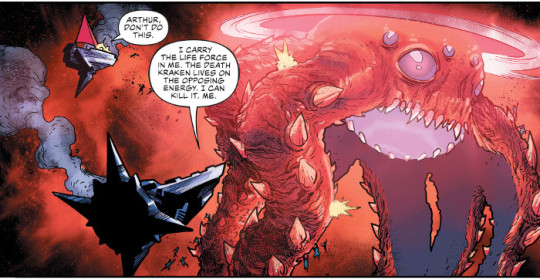
Archie 1941 #3 explores bits of basic training with Archie getting into the usually kind of hijinks that he would and the problems back on the homefront with those left behind. I really like how this series is coming together, looking at some of the basic personal fallout from the war. Also, Peter Krause and Kelly Fitzpatrick’s art remains a huge boon to this series.
| Published by Archie Comics

Barbarella #12 brings Mike Carey and Kenan Yarar’s run on the series to a close, with a kind of retrospective as one of Barbarella’s early antagonists attempts to exact revenge. Very nice guest piece illustrated by Jorge Fornés and Celeste Woods. This has been a fun and entertaining series, definitely feeling like some of the stranger sci-fi that you see out of Europe.
| Published by Dynamite
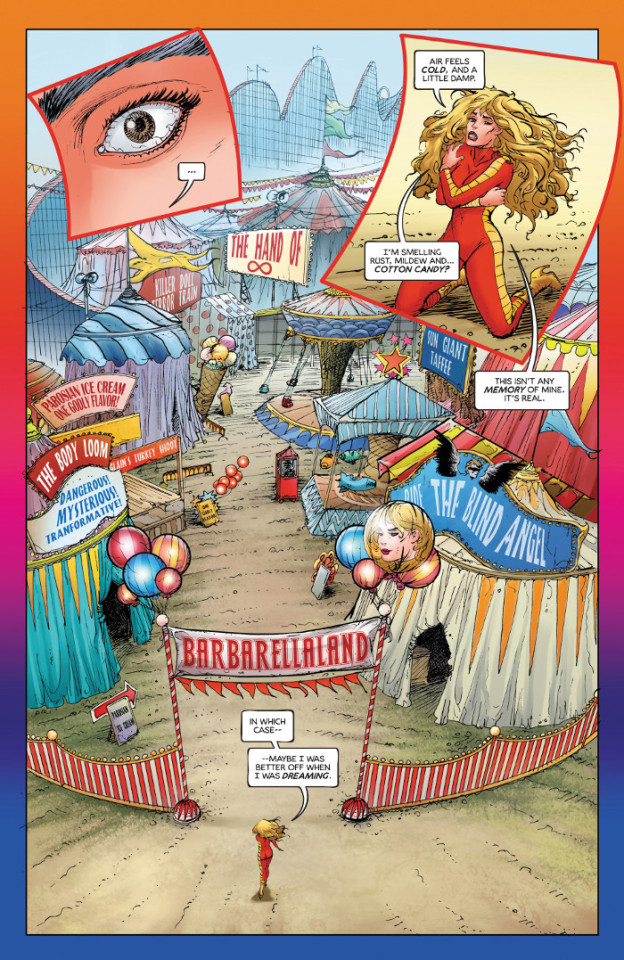
Batgirl #29 has some great art from Paul Pelletier, Norm Rapmund, and Jordie Bellaire for this conclusion to “The Art of the Crime”. Also some very interesting development in the status of the Dark Web and Grotesque.
| Published by DC Comics

Beyonders #4 takes a different approach to the material that the team already has, leading them to a new location wherein they hope to save the world and unravel the mystery. The light humour adds a nice touch to the otherwise dense subject matter.
| Published by AfterShock
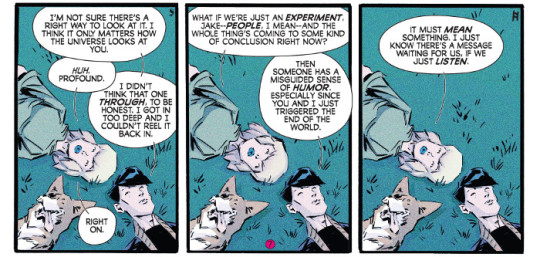
Black Panther #6 gives some much needed backstory, focusing on the Emperor, his rise to power, and his connection to the Wakandan pantheon. Very interesting implications to both where the gods went and in the Emperor being a host for a symbiote. Beautiful guest art from Jen Bartel, Paul Reinwand, and Tríona Farrell.
| Published by Marvel
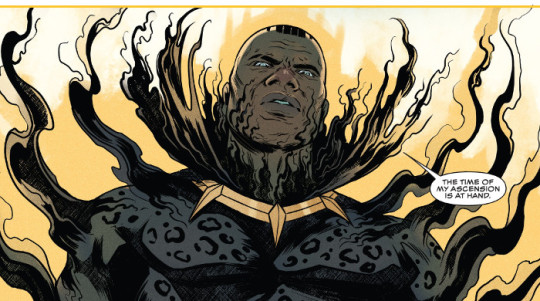
Coda #7 has some pretty big revelations as Hum & Co. confront the Pilot, and his schemes to “fix” his wife look like they’re baring fruit. Si Spurrier and Matías Bergara really are creating something epic here.
| Published by BOOM! Studios
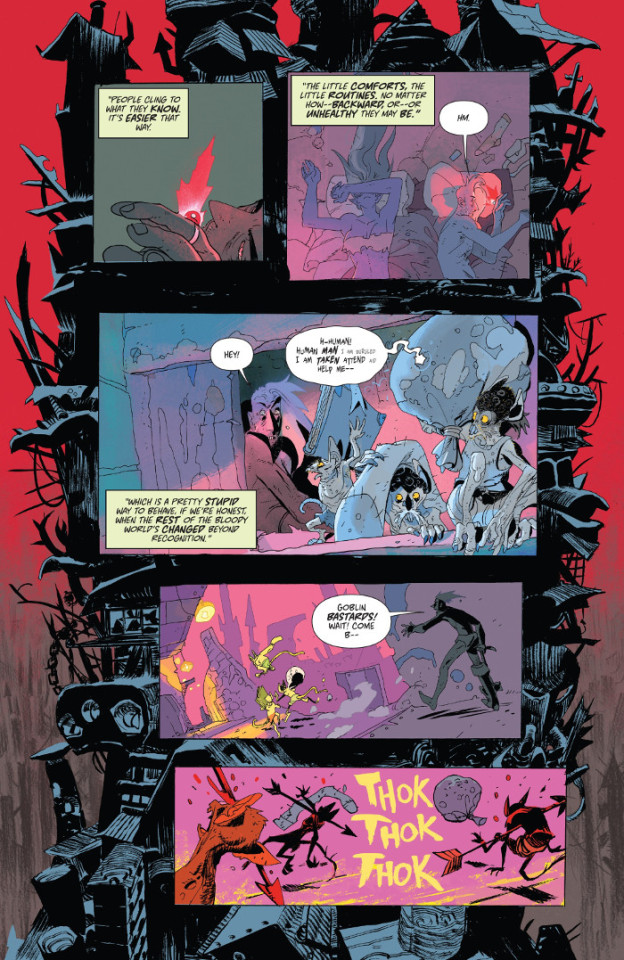
Daredevil #612 concludes “The Death of Daredevil” from Charles Soule, Phil Noto, and Clayton Cowles and with it Soule’s run on the title. It’s good, with some nice character bits and twists for this final chapter.
| Published by Marvel
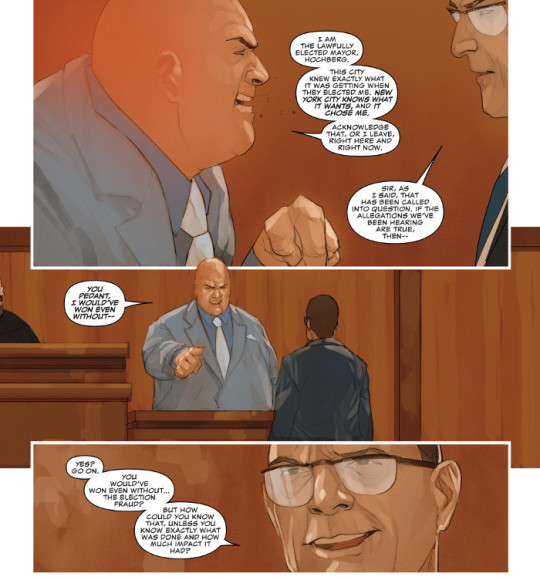
Die!Die!Die! #5 burns Bethany and Theodore as “Paul” turns on them for his side of the battling senators, even as John confronts his side alerting them to something nefarious being afoot. This is still mostly an insane action book, but at least there is something resembling an overarching plot and direction developing.
| Published by Image / Skybound
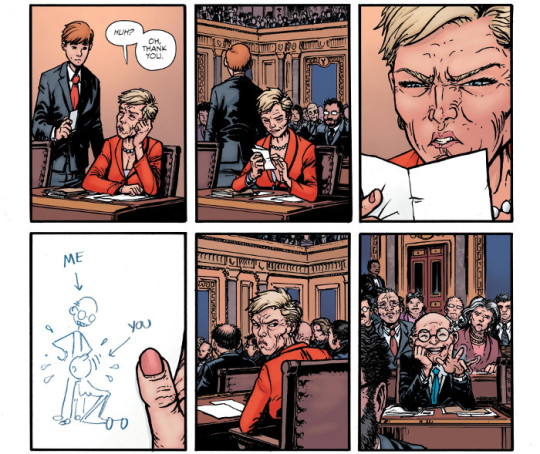
Edgar Allan Poe’s Snifter of Terror #2 gives us an entertaining and somewhat strange adaptation of Poe’s Ligeia from Rachel Pollack, Rick Geary, and Michael Garland. Also a very different take on Jules Verne from Stuart Moore, Ryan Kelly, Rico Renzi, and Rob Steen. This issue is rounded out by a poem, another prose piece, and a wonderful new Black Cat short from Hunt Emerson.
| Published by Ahoy
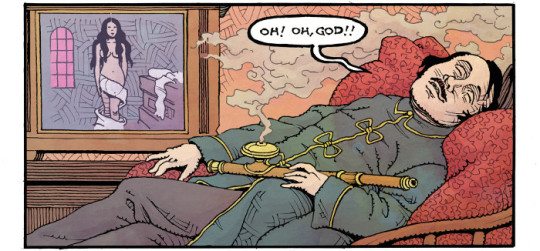
Faith: Dreamside #3 takes Doctor Mirage and Faith into the deadside where they’re searching for Monica Jim’s soul. Very interesting landscapes and characters from MJ Kim and Jordie Bellaire, capturing the oddity of what’s going on in the story.
| Published by Valiant
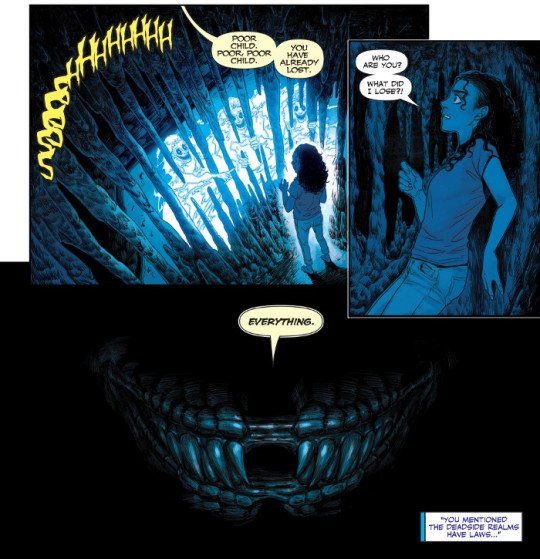
The Flash #59 continues the “Force Quest” arc with a cursory investigation of the slaughter of Gorilla City. We don’t really get any answers there, but there is a broader bit of information about the four forces as a means to protect the multiverse. Also we learn just how bloody that Gemini are willing to get. The avatar of the forces motif that Joshua Williamson is bringing in is very reminiscent of the rainbow-coloured Lanterns of Geoff Johns and of the various Parliaments (and the Red and the Rot) in Swamp Thing and Animal Man, but it’s interesting to see where he’s going with this.
| Published by DC Comics

Hellboy and the BPRD: 1956 #1 begins the next chapter in the BPRD’s history, with change definitely coming as they begin operating under the government’s purview and start having more overt bureaucracy and demands on results. You can definitely see that change in the feeling of alienation that Hellboy’s having from his friends and family as he tries to deal with the loss of his dog. Interesting decision to have different plotlines illustrated by different artists, it kind of echoes the previous breakdown of the series’ stories as discrete units, but now under one umbrella much like the changing nature of the Bureau. Great art in each too from Mike Norton, Yishan Li, and Michael Avon Oeming.
| Published by Dark Horse
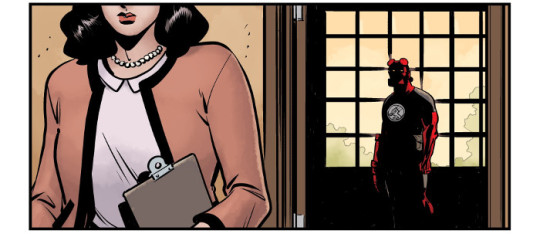
House Amok #3 starts to break the illusion, with Dylan relating how she became disillusion with the madness that her family is living. Gorgeous artwork from Shawn McManus and Lee Loughridge.
| Published by IDW / Black Crown
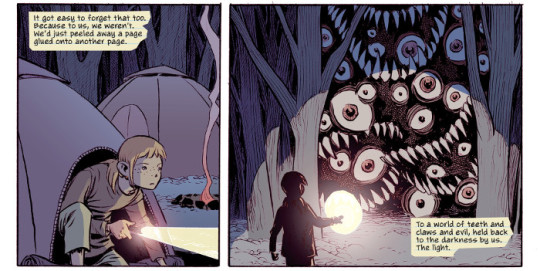
Infinity Wars: Arachknight #2 isn’t a bad conclusion to this origin story for the Spider-Man/Moon Knight mash-up character. Great art from Alé Garza, Victor Olazaba, and Ruth Redmond. Really like the design for Arachknight’s costume.
| Published by Marvel
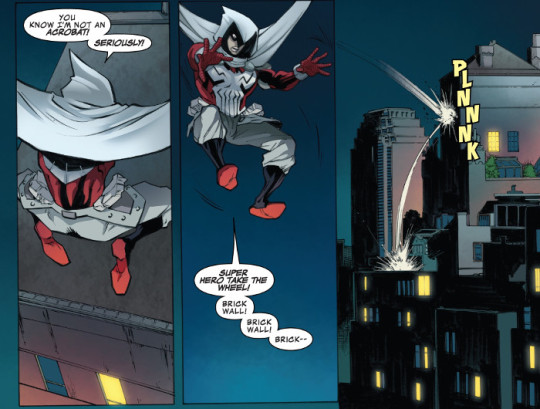
Infinity Wars: Weapon Hex #2 finishes up one of the more balls-out insane Infinity Warps origin tales, from Bens Acker & Blacker, Gerardo Sandoval, Victor Nava, Israel Silva, and Joe Caramagna. This one has been an entertaining mash-up of X-23 with Scarlet Witch and Quicksilver that ports over a lot of the irreverence of an All-New Wolverine or X-23 tale and all the nervous energy of Honey Badger into this story.
| Published by Marvel

Ironheart #1 is off to a pretty good start from Eve L. Ewing, Kevin Libranda, Luciano Vecchio, Geoffo, Matt Milla, and Clayton Cowles, working to give a bit more personality and relatable situations for Riri Williams. There’s still the cold and awkward behaviour from Riri, but Ewing is spotlighting that she’s distancing herself and that may not be great for emotional development. Wonderful artwork from Libranda, Vecchio, Geoffo, and Milla.
| Published by Marvel
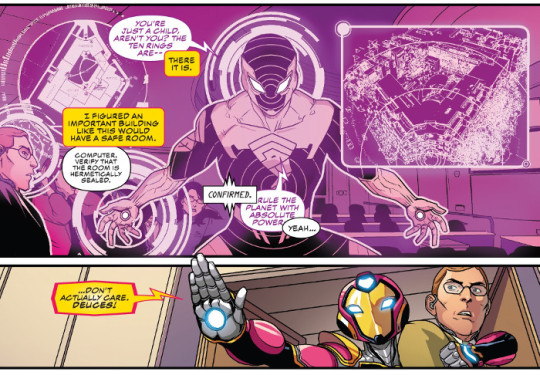
Justice League Odyssey #3 sees Philippe Briones and Jeromy Cox take over the art duties from Stjepan Sejic, It’s definitely a different style, but it still looks good.
| Published by DC Comics
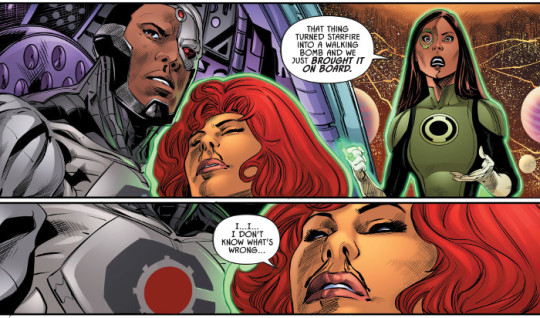
KINO #11 continues this fairly dramatic change in tone and status quo for the series from Alex Paknadel, Diego Galindo, Adam Guzowski, and Jim Campbell. It is really damn good, bringing in a fair amount of mystery and intrigue, with two Alistair Meaths running around.
| Published by Lion Forge / Catalyst Prime

Mighty Morphin Power Rangers #33 gives us a bit of Ellarien’s history as she navigated this universe tending towards entropy and found herself as its sole Ranger. I really like the new direction and mythology that Marguerite Bennett and Simone Di Meo are building.
| Published by BOOM! Studios
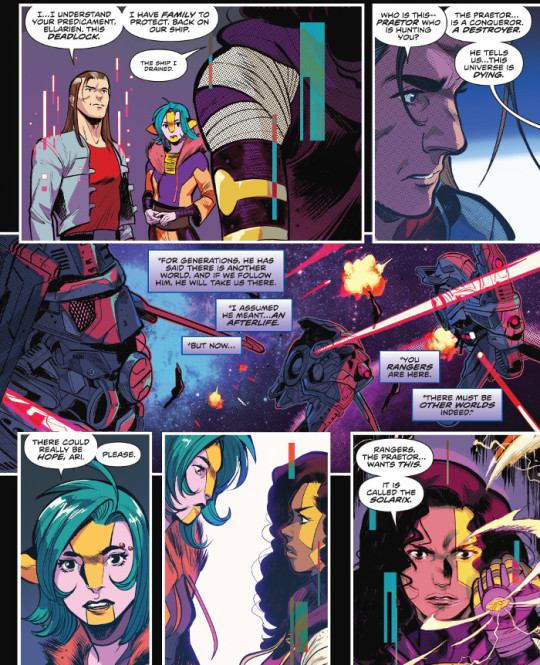
Old Lady Harley #2 introduces us to a very frightening extension of the Batman idea with Bruce plugging himself in to the Bat-computer in order to police Gotham through his Bat-robots. It’s interesting, though, how Frank Tieri can go from this grim vision of the future to the more ridiculous hilarity of Arkham Asylum as an old folks home.
| Published by DC Comics
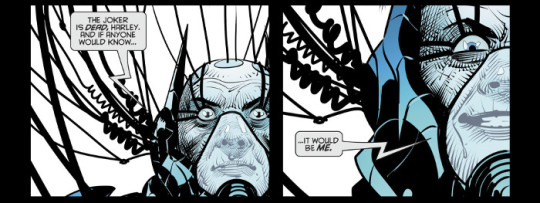
Paradise Court #5 brings the series to a close with the revelation of what’s been going on in the planned community and what its true purpose really is in dramatic fashion. This has been a good little horror thriller from Joe Brusha, Babisu Kourtis, Leonardo Paciarotti, and Taylor Esposito. If you enjoy Bentley Little or Scott Nicholson novels, you’ll probably like this.
| Published by Zenescope
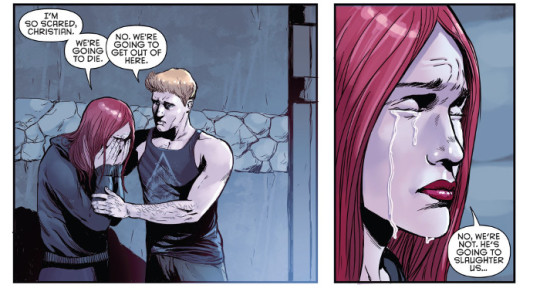
Quincredible #1 is the first Catalyst Prime series to be co-branded with the Roar imprint, Lion Forge’s teen label, (though I suppose at least Superb was also rebranded with it) and it’s a pretty good debut from Rodney Barnes, Selina Espiritu, Kelly Fitzpatrick, and Tom Napolitano. This first issue introduces us to Quin, another teen affected by the Event, who has developed what might be invulnerability. Barnes focuses the story on his community involvement in New Orleans, bringing up class and racial divides, as well as a problem Quin has with bullies, to really make the story feel rich.
| Published by Lion Forge / Roar / Catalyst Prime
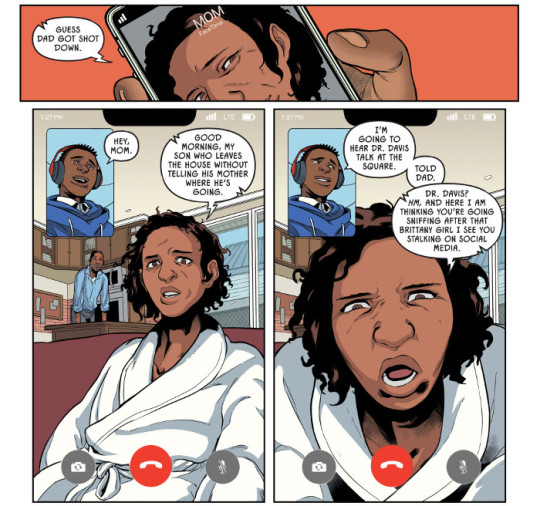
Regression #12 continues to be bleak, entertaining the very real idea that the “bad guys” are going to win. I think that’s probably one of the reasons why I like this series, not because the Valgeroti are right or worth cheering for, but because Cullen Bunn has created a compelling horror tale where the wrong thing feels like a satisfying end resolution. Also it comes with some phenomenal, beautiful, and grisly artwork from Danny Luckert and Marie Enger as they work their terror.
| Published by Image

Scarlet #4 is an interesting penultimate chapter to this mini from Brian Michael Bendis, Alex Maleev, and Josh Reed. Most of it is discussion of what will happen when Scarlet surrenders and her giving her goodbyes to her friends. Really makes you wonder what’s going to happen in the finale.
| Published by DC Comics
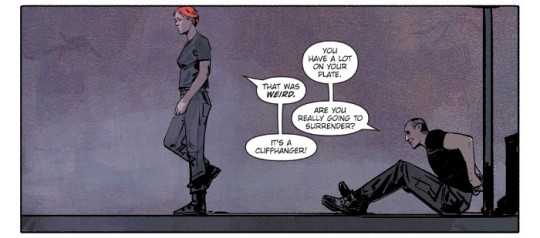
The Silencer #11 begins “Cold Cold Heart” and it feels like the title is working towards an end. I know that many of the other New Age of Heroes titles have been cancelled and are winding down, but I’ve not seen anything in that regard to this one. It could just be working its way through change. In any event, it’s pretty damn good. Seeing all of Leviathan as it exists now is fairly neat and the art from Jack Herbert, Tom Derenick, and Mike Spicer is great.
| Published by DC Comics
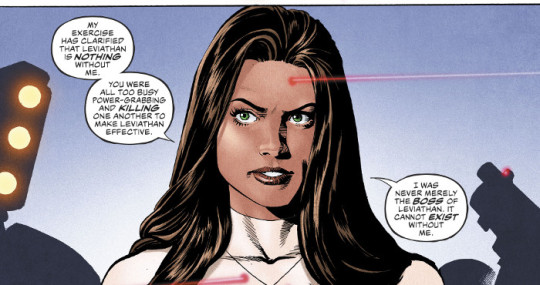
Spider-Girls #2 takes a bit of time to trade stories about Normie Osborn before going to him to warn him about the Inheritors on their world and work some magic on the scrolls of the Spider Cult. Nice character development from Jody Houser here.
| Published by Marvel

Spider-Gwen: Ghost Spider #2 explores an alternate reality where Harry Osborn was Spider-Man and Gwen became the Green Goblin. It’s an interesting emotional ride as we see what happened in this reality, beautifully illustrated by Rosi Kämpe and Ian Herring. One thing that isn’t quite clear, though, is why having our Gwen help their Peter find their Gwen because she’s necessary to help our Gwen is blackmail, though. Maybe I missed something, but it seems like the heroic thing to do.
| Published by Marvel
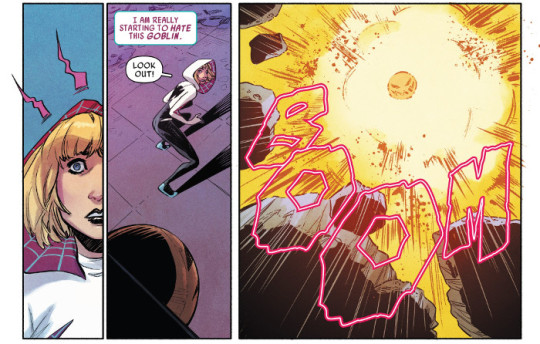
Stranger Things #3 largely works to create an atmosphere of despair and defeat as Will continually tries to reconnect with his mother, or anyone, back in the real world and fails. The artwork from Stefano Martino, Keith Champagne, and Lauren Affe perfectly convey that feeling.
| Published by Dark Horse
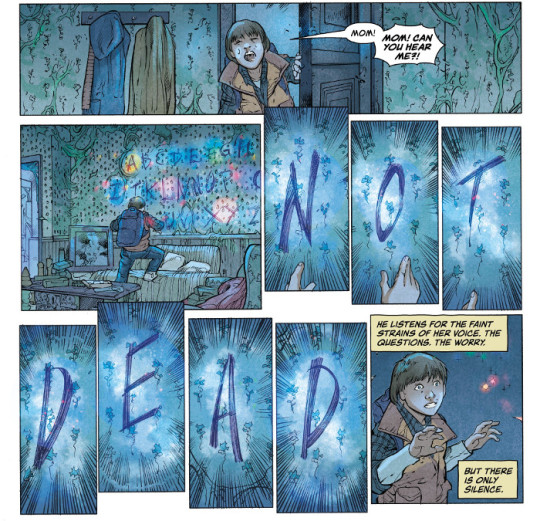
Strangers in Paradise XXV #8 takes a running leap into the strange. Or stranger, as Katchoo returns with the package for Jet. Terry Moore is really taking this tale into a different direction from the initial intrigue thriller plotline. Also, a nice return of Libby and Sam from Motor Girl.
| Published by Abstract Studio
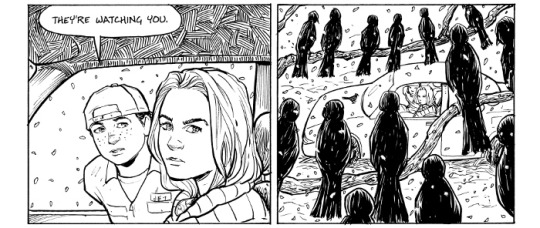
Teenage Mutant Ninja Turtles #88 has quite a few “holy crap” moments as the Mutanimals aid the Turtles in repelling the EPF from Burnow Island. Huge revelations about Bishop’s history and a hero moment from Slash. Dave Wachter and Ronda Pattison deliver some incredible artwork all throughout.
| Published by IDW
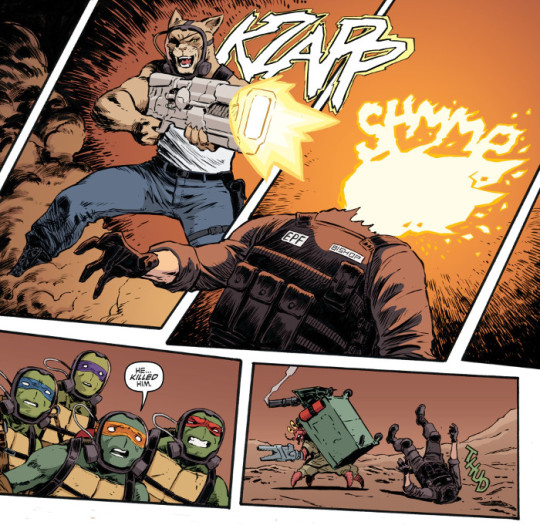
Teenage Mutant Ninja Turtles Macro-Series: Leonardo #3 is one of the most beautiful Turtles books I’ve seen. The art from Sophie Campbell and Brittany Peer is gorgeous, guiding us through a fairly introspective tale of what Leonardo really wants out of life, while still advancing major plot points with the fate of the Foot Clan.
| Published by IDW
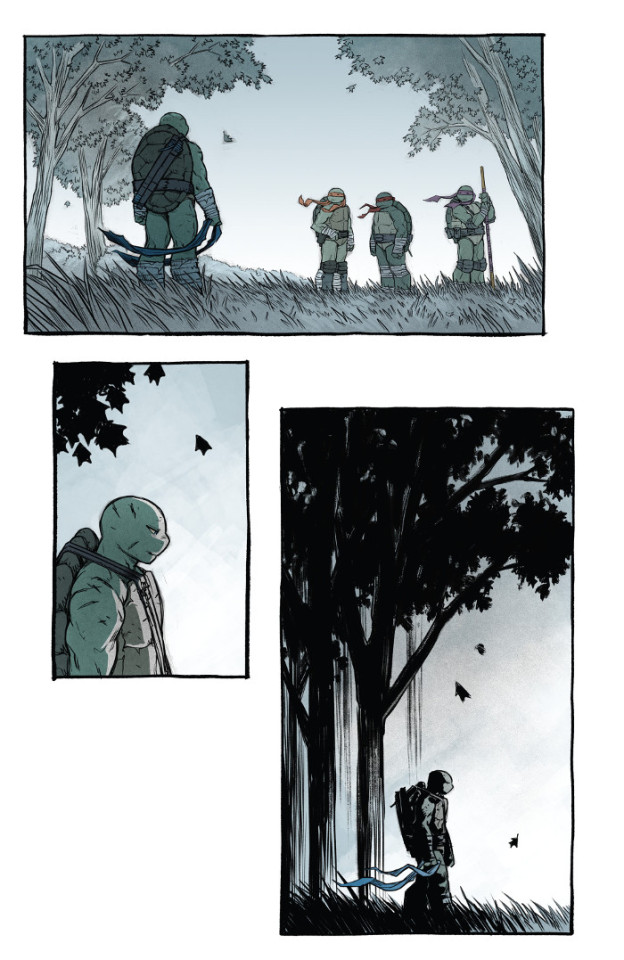
These Savage Shores #2 continues this brilliant series from Ram V, Sumit Kumar, Vittorio Astone, and Aditya Bidikar. It is a thoroughly stunning combination of horror tale, tragic romance, and political drama rolled into one absolutely beautiful package. The world is deep and enthralling, brought to life in amazing use of mostly variants on 9-panel grids from Kumar and Astone. The design sense alone makes this series interesting to read just from a technical perspective, but Ram V and Kumar put so much into the story and storytelling that it transcends just style. This is a truly great comic.
| Published by Vault
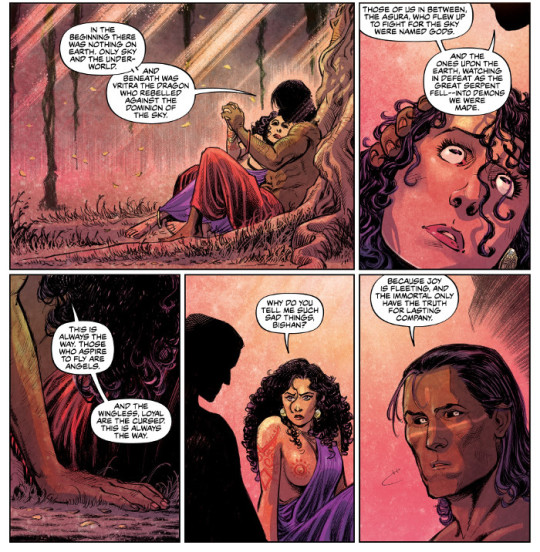
Titans #30 continues to break the team into pieces. The rebuilding, if they ever make it there, should be interesting.
| Published by DC Comics
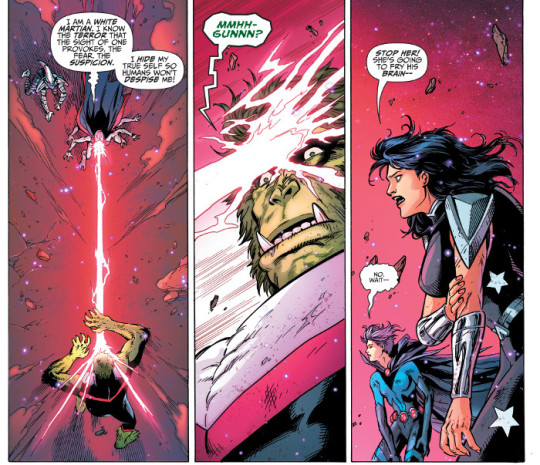
Vampirella/Dejah Thoris #3 nicely moves this along, introducing even more of the various peoples of Mars as Vampirella searches for aid for her people. Great art from Ediano Silva and Dinei Ribeiro.
| Published by Dynamite
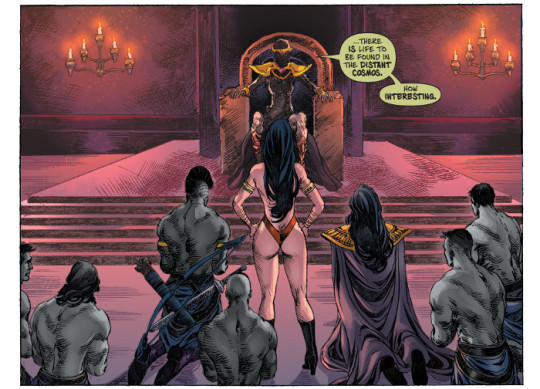
The Warning #1 is fairly decompressed, slow, methodical, but there’s still an interesting premise here of genetic manipulation of soldiers and an alien invasion. The art from Edward Laroche and Brad Simpson is very nice. Laroche has a style somewhat akin to Chris Sprouse and Jonathan Luna and it works to give this a bit of distance echoed by the existential narration.
| Published by Image
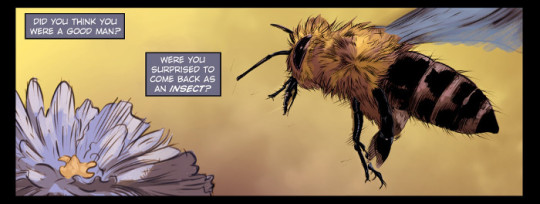
Wonder Woman #59 continues G. Willow Wilson and Cary Nord’s first arc on the series, with an interesting rebirth and reinterpretation of Ares that’s possibly deadlier than the previous one. Love the artwork from Nord, Mick Gray, and Romulo Fajardo Jr. So far this has felt a lot like Greg Rucka’s original run on the series over a decade ago, a nice mix of modern sociopolitical analogues and DC’s take on Greek mythology.
| Published by DC Comics
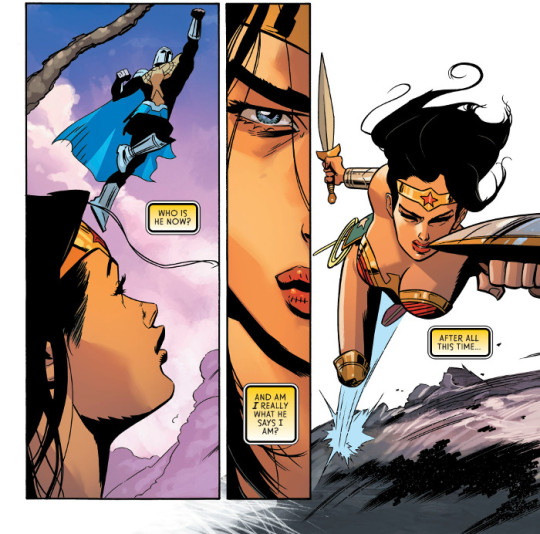
X-O Manowar #21 sees Juan José Ryp somehow level up his artwork. The designs, detail, and storytelling this issue are just incredible, made even more beautiful with Andrew Dalhouse’s colours. Matt Kindt, Ryp, Dalhouse, and Dave Sharpe are crafting a very interesting next chapter in what started as the Divinity saga, building upon the recent Eternity mini as Aric and co. confront David Camp in New Eden.
| Published by Valiant

Other Highlights: Atomic Empire, Books of Magic #2, Come Into Me #4, DC Nuclear Winter Special #1, Fantastic Four #4, Hex Wives #2, Invader Zim #37, Jim Henson’s Labyrinth: Under the Spell #1, Man-Eaters #3, Marvel Action: Spider-Man #1, Marvel Two-In-One #12, This Nightmare Kills Fascists, Oh S#!T It’s Kim & Kim #4, Old Man Hawkeye #11, Pandora’s Legacy, Red Sonja #23, Redneck #17, Rick & Morty #44, Sex Death Revolution #2, Spider-Man/Deadpool #42, Star Wars: Darth Vader #24
Recommended Collections: A Walk Through Hell - Volume 1, Amazing Spider-Man - Volume 1: Back to Basics, Black Hammer Library Edition - Volume 1, The Book of Ballads and Sagas, Eternity Girl, GI Joe: A Real American Hero - Volume 21, Harbinger Wars 2, The Highest House, The Mighty Thor - Volume 5: Death of the Mighty Thor, Quicksilver: No Surrender, The Realm - Volume 2, Spider-Man/Deadpool - Volume 7: My Two Dads, Summit - Volume 2: Price of Power

d. emerson eddy does not know, and has never met, those three people who have never been in his kitchen.
3 notes
·
View notes
Text
Featuring
THE WRONG EARTH by Tom Peyer and Jamal IgleHIGH HEAVEN by Tom Peyer and Greg Scott
CAPTAIN GINGER by Stuart Moore and June Brigman
And The All Star Anthology Series EDGAR ALLAN POE’S SNIFTER OF TERROR
Featuring Contributions by Mark Russell, Peter Snejbjerg, Tom Peyer, Hunt Emerson, Fred Harper, Cienna Madrid, Carly Wright and More
Every AHOY Comic Book Magazine Features a Full Length Lead Story *And* Extra Content, Including Prose Stories by Grant Morrison, Cartoons by Shannon Wheeler, Poetry by Hart Seely and Backup Comic Book Stories
(Yes, We Said Poetry)
AHOY Comics is looking to shake up the publishing industry with a bold new format: comic book magazines. The startup company is the brainchild of Publisher Hart Seely, an award-winning reporter whose humor and satire has appeared in The New York Times and on National Public Radio; two founding editors of DC Comics’ Vertigo imprint, Tom Peyer and Stuart Moore; and Chief Creative Officer Frank Cammuso. The comic book magazines will feature traditional, full length comic book stories―by Peyer (Hourman) and Moore (Deadpool the Duck) and top talents including Jamal Igle (Black), Mark Russell (Flintstones), Ann Nocenti (The Seeds) ―accompanied by extra material, including prose fiction by writer Grant Morrison (Happy!), cartoons by Shannon Wheeler (God is Disappointed In You), poems by Hart Seely (Bard of the Deal: The Poetry of Donald Trump), and traditional comic book back up stories. AHOY Comics will debut in comic book stores across the country in September of 2018.
“It’s time to expect more from comics,” said AHOY Comics Editor-in-Chief Tom Peyer. “AHOY Comics offers a wide breadth of contributors from the worlds of mainstream and indie comics and humor magazines. We’re publishing comic book magazines with full length stories, backup stories, one-off gags by a bestselling New Yorker cartoonist, political poetry by a regular Poltico contributor, and prose stories by Grant Morrison, Cienna Madrid and a sundry of talent. And I don’t want it to sound too serious, because these comic book magazines are both fun and funny. It really is a unique reading experience.”
The company will launch in September 2018 with two titles:
THE WRONG EARTH 6 Issue mini-series by Tom Peyer and Jamal Igle
AHOY Comics launches with a biting superhero satire written by Tom Peyer (Captain Kid, Hourman), penciled by Jamal Igle (Black, Supergirl), inked by Juan Castro (Transformers),and colored by Andy Troy. On one world, Dragonflyman and his sidekick Stinger enjoy a life of adventure. On another Earth, the Dragonfly hunts criminal parasites like a lethal exterminator. But what happens when these two heroes change places?
“I just want you to know that I’ve loved Tom Peyer’s genius brain for thirty years and THE WRONG EARTH is just pure, undiluted Tom Peyer as it exists in its most natural form. If you love superheroes, you NEED this. If you HATE superheroes, this will change your mind.”―Mark Millar
“I knew this was going to be good when I saw Peyer and Igle on the credits, but now I really want to see how it all plays out.”―Jeff Parker
“THE WRONG EARTH is far more than a one-note gag–Tom and Jamal have made a surprisingly deep exploration and commentary on where this medium has been, how it got to where it is, and where it can go.”―Mark Waid
On sale on September 12, 2018, THE WRONG EARTH debut issue is a full color, 40 page comic book magazine retailing for $3.99, with extras including:
A prose story by comics legend Grant Morrison: ‘HUD’ HORNET’S HOLIDAY IN HELL, illustrated by best-selling artist Rob Steen
A mock “Golden Age” Stinger solo story, by Paul Constant and Frank Cammuso
A cartoon by Shannon Wheeler
HIGH HEAVEN 5 Issue Mature Readers mini-series by Tom Peyer and Greg Scott
Chronic malcontent David Weathers dies and goes to Heaven—where everything is terrible, and everybody hates a complainer. HIGH HEAVEN is a savage satire by writer Tom Peyer (Hourman, Batman ’66) with art by Greg Scott (Black Hood, X-Files), colored by Andy Troy.
“Delivered with that Tom Peyer panache and his sneaky habit of undercutting reader expectations at every turn. And gorgeous art by Greg Scott, giving it all personality and (seedy) visuals. I’m hooked.”―Kurt Busiek
“HIGH HEAVEN has a great premise. I loved it and can’t wait to see where it goes next. Also: the Hashtag: Danger back-up was a riot. Chris Giarrusso is just the best!”―John Layman
“As gorgeous as it is absurd.”―Alisa Kwitney
On sale, September 26, 2018, HIGH HEAVEN’s debut issue is a full color, 40 page comic book magazine retailing for $3.99, with a cover by Mad Magazine’s Richard Williams and extras including:
A HASHTAG: DANGER backup story by Peyer, with art by Chris Giarrusso (G-Man, Mini-Marvels)
A cartoon by Shannon Wheeler
An all-new prose story by comics legend Grant Morrison: FESTIVE FUNTIMES AT THE NEW WORLD’S FAIR, illustrated by acclaimed artist Rick Geary
In October, AHOY Comics will launch a creator owned title:
CAPTAIN GINGER 4 issue mini series by Stuart Moore and June Brigman
When the human race died out, the cats inherited the Earth! Or at least one starship. Now the intrepid Captain Ginger struggles to keep his fellow felines united against a hostile universe. Thirty-five pages of comic adventure—with a bite—by writer Stuart Moore (Deadpool the Duck, Batman: Noir Alley) artist June Brigman (Power Pack), inker Roy Richardson and colorist Veronica Gandini.
“The best books usually transport me into a world with which I am largely unfamiliar and reveal its mysteries to me, whether it’s the mean streets of a great urban metroplex, a small village lying somewhere on a distant steppe in central Asia, or a starship full of individualist cats trying to keep it together long enough to survive…these may very well be the characters that June was born to draw and Stuart was born to write!” ― Walter Simonson
“This is a great start to a great book by Stuart and June. The Captain and his misbegotten cat crew can count me along for the long haul!” ― Peter Gross
“This comic book is INSANE, in the best possible way when one describes something as “insane”! I can’t say I got too excited when I first heard the concept, “Cats in Space”, but Stuart Moore and June Brigman have got it goin’ on! CAPTAIN GINGER rocks! It’s solid sci-fi adventure, beautifully illustrated and electric with wonderful diverse characters, who are CATS (?!)! This “puppy” smells like a sleeper hit (but that could just be the space kitty litter)!” ― Mike Allred
On sale, October 17, 2018, CAPTAIN GINGER’s debut issue is a full color, 48 page comic book magazine retailing for $3.99, with extras including:
An all-new text story by comics legend Grant Morrison: THE ELECTRIC SKY BEAR THAT INSPIRED BEN FRANKLIN, illustrated by Phil Hester
A cartoon by Shannon Wheeler
October will also see the debut of an all star anthology series:
EDGAR ALLAN POE’S SNIFTER OF TERROR 6 issue Mature Readers mini series
EDGAR ALLAN POE mangles classic tales and brand new stories in this cross between Drunk History and Tales from the Crypt! First, meet AHOY’s own alcohol-damaged version of Poe in The Facts in The Case of M. Valdemar, adapted by Tom Peyer (Batman ‘66) and drawn by Fred Harper. Then: Sugary cereal meets vampirism in Dark Chocolate, by writer Mark Russell (The Flintstones) and artist Peter Snejbjerg (Starman).
On sale, October 31, 2018, EDGAR ALLAN POE’S SNIFTER OF TERROR’s debut issue is a full color, 40 page comic book magazine retailing for $3.99, with extras including:
Hunt Emerson’s take on The Black Cat
Unsettling verse by Cienna Madrid illustrated by Carly Wright
“There is no house style at AHOY Comics, but one of the things we aim to do is to bring a sense of humor to the comics,” said AHOY Comics “Dark Ops” Manager and Captain Ginger co-creator Stuart Moore. “We’re publishing stories with a strong personal vision that provoke an occasional laugh. You know, like Preacher. Or, more recently, comics written by Mark Russell, whose sensibilities are a great match for ours. It’s a dark humor, we admit.”
Upcoming AHOY Comics will feature stories by Gary Erskine, Ryan Kelly, Mariah McCourt, Linda Medley, Peter Milligan, Dean Motter, Ann Nocenti, Rachel Pollack, Roger Stern and others.
“AHOY Comics offers an abundance of originality and offbeat humor,” said Hart Seely. “Some might say that launching a publishing initiative in this moment is folly. We disagree! We’re publishing comic magazines with high standards. Each issue features beautiful designs, vibrant art, exceptional colors, experienced editors and dynamic stories. We aren’t planning on being an overnight success. We’re not here to exploit IP or make movies. We’re here to publish stories for people who love comics and who love to read.”
For more updates on AHOY Comics on Twitter, Facebook and Instagram.
AHOY Comics Debuts This Fall With Comic Book Magazine Format Featuring THE WRONG EARTH by Tom Peyer and Jamal IgleHIGH HEAVEN by Tom Peyer and Greg Scott…
1 note
·
View note